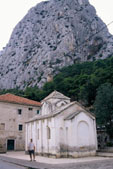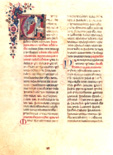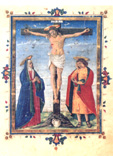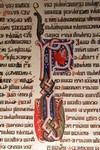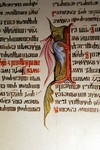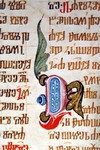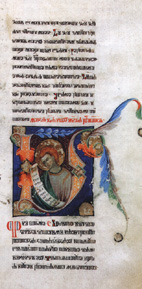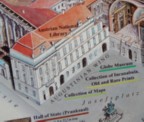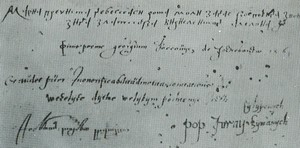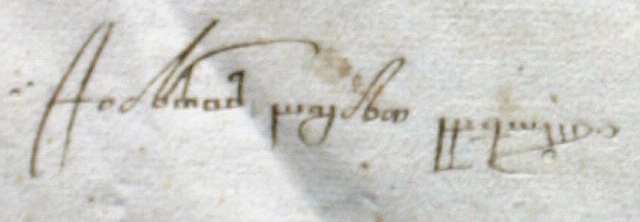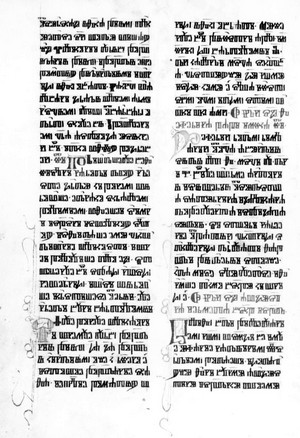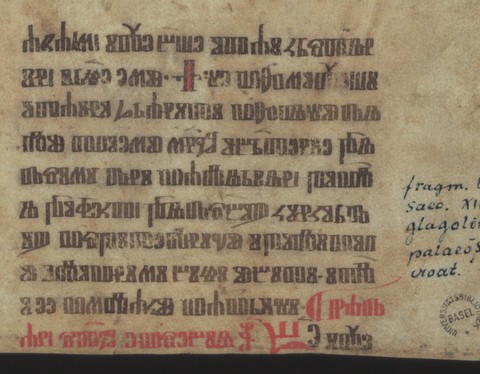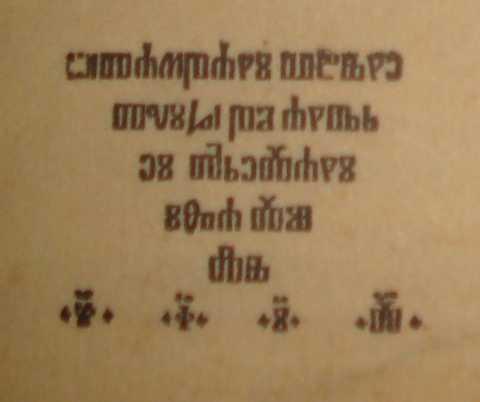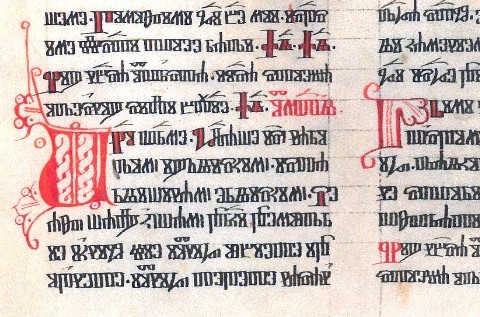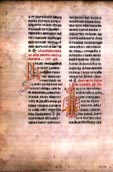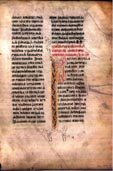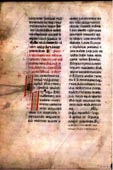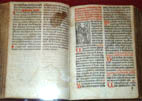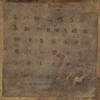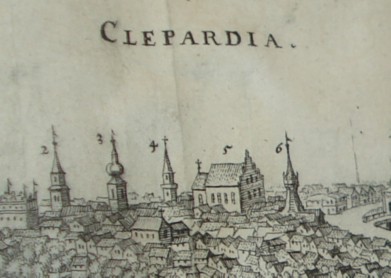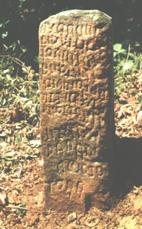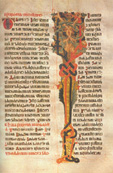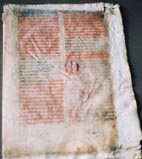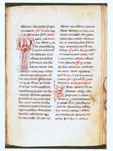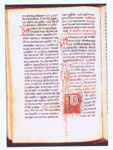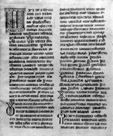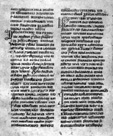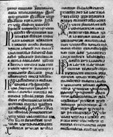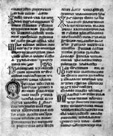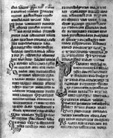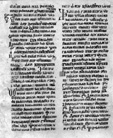- Austria: Vienna, Innsbruck, Klagenfurt, Schwarzau, Linz, Güssing, Graz, Losensteinleitn
- Bosnia-Hercegovina: Sarajevo (Zemaljski muzej), Fojnica (Muzej franjevackog samostana), Humac (Franjevacki muzej), Posusje (Grac), Banja Luka (Muzej Bosanske krajine), Livno, and neighbourhood of Jajce (discovered in 1996).
- Bulgria: Sofia
- Czech Republic: Praha, Sazava
- Denmark: Copenhagen
- France: Paris, Reims, Tours, Strasbourg
- Germany: Berlin, Kassel, Weimar, Wertheim, Stuttgart, Magdeburg, München, Frankfurt am Main, Trier, Tübingen, Bamberg, Gotha
- Hungary: Budapest
- Italy: Rome, Trento, Padova, Firenza, Milano, Sienna, Vicenza, Trieste, Aquileia, Cividale, Goriza, Milano, Aquileia, Assisi, Duino, Fabriano
- Montenegro - in Boka kotorska, Bogdašić, Kostajnica, Škaljari
- The Netherlands, Delft
- Norway, Oslo
- Poland: Krakow, Holesnica, Wroclaw
- Portugal: Porto
- Romania: Sibiu
- Russia: Moscow, St.Petersburg
- Serbia: Belgrade
- Slovakia: Martin, Bač, Krtiš, Spišska Nova Ves
- Slovenia: Ljubljana, Mojstrana, Hrastovlje, Kopar, Novo Mesto, Križe pri Tržiču, Mengeš, Podbrežje, Šmartno pri Litiji, Vipava, Vinica na Kupi
- Spain: Madrid, Salamanca
- Sweden: Uppsala , Stockholm
- Switzerland: Basel
- Turkey: Constantinople
- Ukraine: Kiev, Odessa
- United Kingdom: London, Cambridge, Oxford
- USA: New York, Washington, Princeton, Harvard Univ., Yale Univ.
- the Vatican
Croatian Glagolitic Manuscripts kept outside of Croatia
Darko Zubrinic, Zagreb (1995)translation into Croatian
SCATTERED HERITAGE... (Petar Zoranic, Mountains, 1569)
There is no doubt that anonymous creators of the Croatian Glagolitic Script of the angular type - Croatian Benedictines - were influenced by pre-Romanesque architecture (there existed about 150 pre-Romanesque and Romanesque Croatian churches, mostly along our littoral, built between the 9th and 12th centuries, of which 15 have been preserved completely). To see this, it suffices to have a look at a very nice, church-like Glagolitic letter L below. Compare e.g. with the pre-Romanesque Church in Priko near Split, where the Glagolitic mass was served (in this region both Glagolitic and Cyrillic Script were in use).
Glagolitic M looks like a fortress. Ligatures in our national Script (there are hundreds of them) often have the composition of real buildings (see e.g. ML below)! Initials of Croatian handwritten Missals and Breviaries are often beautifully painted and ornamented.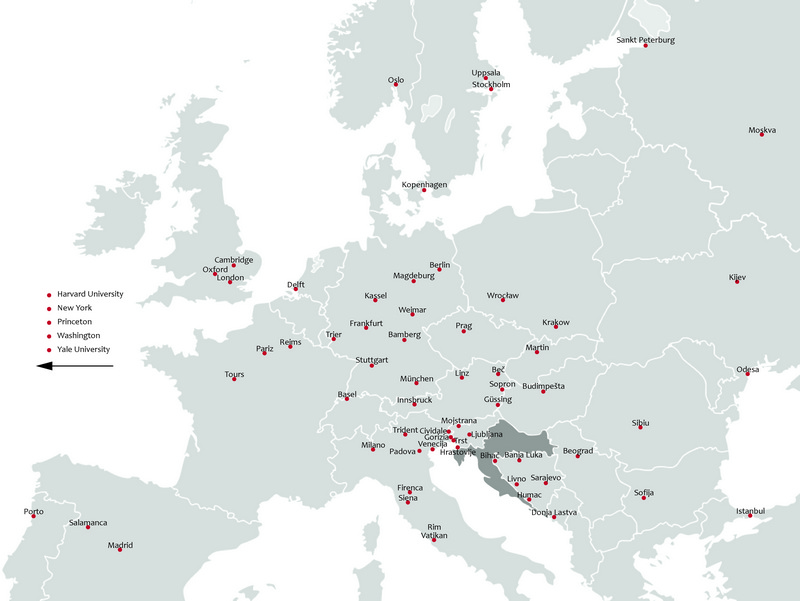
The map has been created by Filip Cvitić, Zagreb, on the basis of data provided by this web page.
On this map, only the cities of Madrid and Salamanca are hypothetical.
Except in Croatia itself,
numerous Croatian Glagolitic manuscripts are kept in 27
countries,
in more than 80 cities, mostly in national libraries and museums
throughout
Europe.
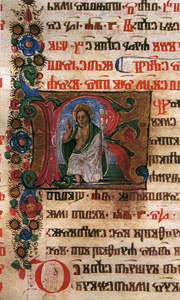 The Princeton
University
Library, Princeton, USA, is in
possession of one leaf of a beautiful Second
Vrbnik Missal
from 1462 (see a part of a page from the book on the right). The leaf
is the only one missing from the book, cut out probably in the
beginning of 20th century. After James O'Brien discovered it around
1970 in the library, he tried to get it back to Croatia, to the 2nd
Vrbnik Missal where it used to be for centuries, but in vain.
The Princeton
University
Library, Princeton, USA, is in
possession of one leaf of a beautiful Second
Vrbnik Missal
from 1462 (see a part of a page from the book on the right). The leaf
is the only one missing from the book, cut out probably in the
beginning of 20th century. After James O'Brien discovered it around
1970 in the library, he tried to get it back to Croatia, to the 2nd
Vrbnik Missal where it used to be for centuries, but in vain.I owe this information to rev. Josip Kosic from the town of Vrbnik, dr. Marica Cuncic, and dr. Milan Mihaljevic. The leaf was named Garrett MS. 25 after a certain Robert Garrett (Magg Brothers from London) who donated it to the Library in 1942. Garrett purchased it probably no later than in 1920s. It would be nice to rename it to, say, Vrbnik MS 25. Many thanks to Mr. James O'Brien (Princeton) for his kind help. In 2002 I obtained a copy of the Princeton page from Mrs. Marija Kraljic, Vrbnik (many thanks also to her colleagues in New Jersey):
If you live in New York, we strongly recommend you a visit to The Pierpont Morgan Library where you will find a beautiful Croatian Glagolitic Missal there (1400-1410) - known as the New York Missal. It was reprinted by Verlag Otto Sagner, Munich in 1977. (By the way, J. Pierpont Morgan was one of financers of Nikola Tesla.)
In Yale University Library (Beinecke library) in New Haven the Beinecke Croatian Glagolitic Fragment is kept from the late 14th or early 15th century. It is a bifolium containing a fragment of a Croatian missal. The writing is angular Glagolitic with features of the Croatian recension of Church Slavonic. Folio 1, columns a and part of b, contain the reading of the Vigil of All Saints (Revelation 5.6-12). See photo 1 and photo 2. Many thanks to dr. Milan Mihaljević for this information.
Croatian Glagolitic in the USA (in Croatian)
However, the most beautiful specimens of this unique heritage of the Croatian culture are kept in
Turkey, Constantinople (Topkapi Saray, the library of the Turkish sultans), where you can see the famous Missal of Bosnian prince Hrvoje Vukcic Hrvatinic, better known as Hrvoje Missal, written in 1404 (reprinted jointly by Croatian and Austrian publishers in Graz). It has 96 miniatures, 380 initials and 488 vellum pages. The book is kept in the mentioned Library of Turkish sultans in a glass box, and alone.
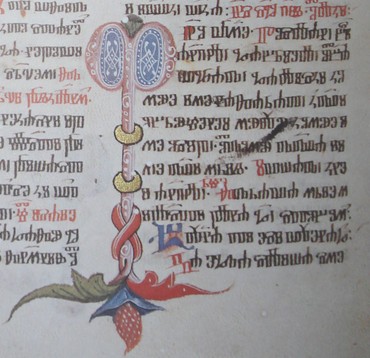
|
V |
V |
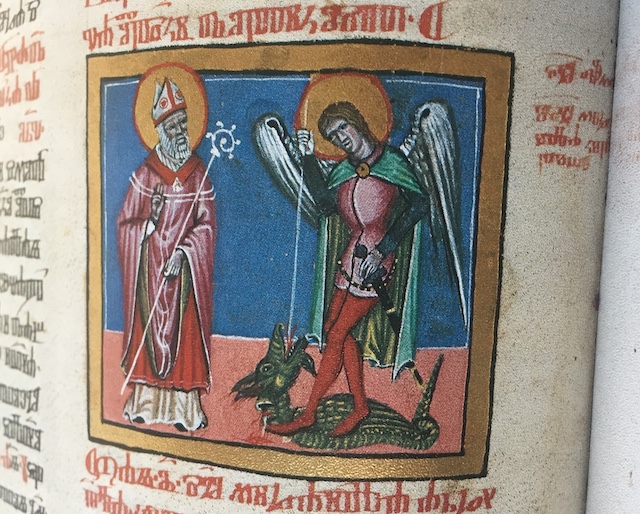
On leaf no 140a on the right margin it is written in the Glagolitic Script: "Svetago Dujma i Svetago Mihovila kipe piši"
("Here, draw the figures of St. Duimo nad St. Michael").
This is Butko's hint to anonymous illumainator where to draw a picture of St. Duimo and St. Michael.
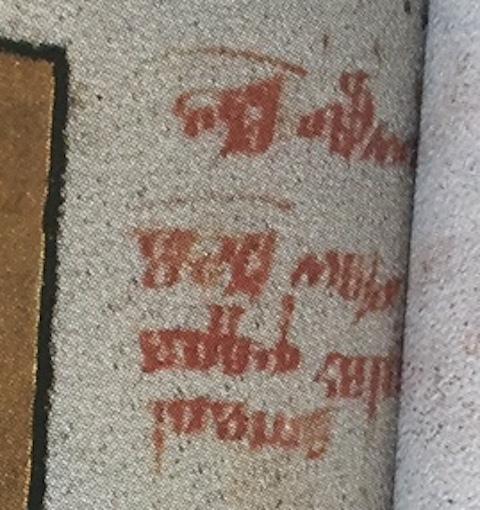
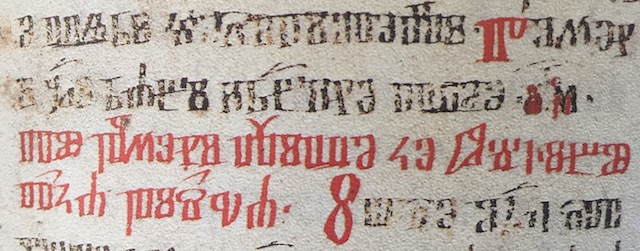
On leaf no 169a, in red ink, it is written: "Tu pomeni žive ke hoć' i Butka pisca"
(Here, mention those alive, as well as Butko the writer.)
Due to this, we know that the name of the writer of the Hrvoje missal was Butko.
Austria, Vienna (Austrian National Library), where you can see
- Missal of Croatian prince Novak (1368),
- the Roch Missal (1420), written probably by Bartol Krbavac
- Breviary of Vid from Omisalj (1396),
- Quadriga of Simun Greblo 1493 (Istria),
- the Frascic psalter (1463),
- the Brozic breviary (1561; with 250 printed ligatures, which seem to be unique in the history of printing),
- Vienna folia (11th century),
- 2 leaves of the Marian
Evangel (end of 10th century;
172 leaves are in Moscow).
Out of five preserved samples of the Baromic breviary (1493 incunabulum) one is kept in Schwarzau (Parma library; one is also in the Staatsbibliothek in München and in Sibiu in Romania). A large number of Glagolitic fragments are kept in other Austrian towns: Güssing, Trier, Linz, Innsbruck. Two parchment leaves of the famous Cloz Glagolitic codex from the 11th century are kept in Innsbruck. Another 12 leaves from the same codex are in the small commune library in Trento (Italy). As remarked by academician Branko Fucic, their illuminations with sea elements (like octopus; also connections with the beneventana style) indicate the codex was prepared in the Croatian south, near the sea. Originally, until the end of 15th century (i.e until the fall of the island of Krk under the Venetian rule), the book had 500 vellum leaves (i.e. 1000 pages), and was bound in gold and silver. Soon after that, only 14 pages of this luxurious book survived. Regarding Glagolitic manuscripts, we know of altogether 6 Glagolitic Missals and 9 Breviaries kept in Austrian State libraries, written in the period between 10th to 15th centuries. They are described in the monograph of Gerhard Birkfellner: "Glagolitische und Kyrillische Handschriften in Österreich", Österreichische Akademie der Wissenschaften, Wien, 1975.
Hrvatske glagoljičke inkunabule
On one of the last pages of the famous Klimpeh Missal (Burgenland - Gradisce), printed in 1501 in Ostrogon, there are several inscriptions in the Glagolitic, Latin and Cyrillic, that the earliest Croatian priests there wrote between 1543 and 1563.
On the bottom left we can see "Zdravo budi bošju" written in very nice Croatian Glagolitic:These are also the oldest known written documents of Croats in Gradisce (Burgenland) in Austria, see [Krpan, p. 214 and facsimile on p. 224], as well as [Katharina Tyran].
In the archive of prince Karl Auersperg, Upper Austria, in the town of Losensteinleiten, an important glagolitic transcription of the description of the 1566 Battle at Siget is written in 1566 or 1567. The glagolitic text has been described among others by Stjepan Ivšić, according to who the manuscript originates from Pokuplje near Ozalj.
In 2016, two fragments of a Croatian Glagolitic Breviary from the 14th century have been discovered in Klagenfurt (Kärtner Landesarchiv), written in Istria. They have been described by [Milan Mihaljević].
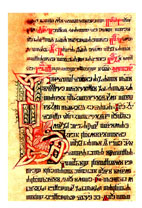 The
famous Vatican Library
possesses about a dozen of Croatian's earliest and most valuable
Glagolitic Missals and Breviaries, and also some Croatian Cyrillic
liturgical texts. The oldest extant Glagolitic Missal (Omisalj
Missal, 14th century) is kept
there. Croatian handwritten glagolitic books kept in the Vatican
apostolic library are described in [Dzurova,
Stancev, Japundzic]:
The
famous Vatican Library
possesses about a dozen of Croatian's earliest and most valuable
Glagolitic Missals and Breviaries, and also some Croatian Cyrillic
liturgical texts. The oldest extant Glagolitic Missal (Omisalj
Missal, 14th century) is kept
there. Croatian handwritten glagolitic books kept in the Vatican
apostolic library are described in [Dzurova,
Stancev, Japundzic]:
- Vat. Slav. 3,
- Vat. Slav. 11, 14/15. st., glagolitic amulet, prayers,
- Vat. Slav. 19, breviary,
- Vat. Slav. 23, breviary,
- Borg. illir. 4 (Borgiano illirico), middle of 14th century, missal,
- Borg. illir. 5, middle of 14th century, breviary, part I,
- Borg. illir. 6, 14th century (third quarter), breviary, part II,
- Borg. illir. 8, 1435, missal,
- Borg. illir. 9, 1445, "Zrcalo" (mirror) of deacon Luka from Vrbnik, spiritual readings, in Croatian vernacular,
- Borg. illir. 10, 1485, breviary,
- Borg. illir. 11, Confessional book, Antonino Pierozzi,
- Borg. illir. 19, 20, 21, three copies of Brozic breviary, 1561,
- Borg. illir. 22, breviary, 19th century,
- Borg. illir. 23, I-III,
- Cap. S. Pietro D215, 15th century.

Colophon of the 1483
incunabulum on its
last page:
Ljet
Gospodnih 1483 miseca pe- |
rvra dni 22 ti misali biše | svršeni
(AD 1483 in February 22 this missal was completed)
One of three samples of the Brozić breviary from 1561 kept in the Vatican Library has a parchment binding corresponding to the Kosinj breviary from 1491. Since the only preserved copy of the Kosinj breviary, kept in Venice (Marciana National Library), was printed on paper, this means that a part of the edition had been printed on parchment. This information is due to academician Anica Nazor 2012.
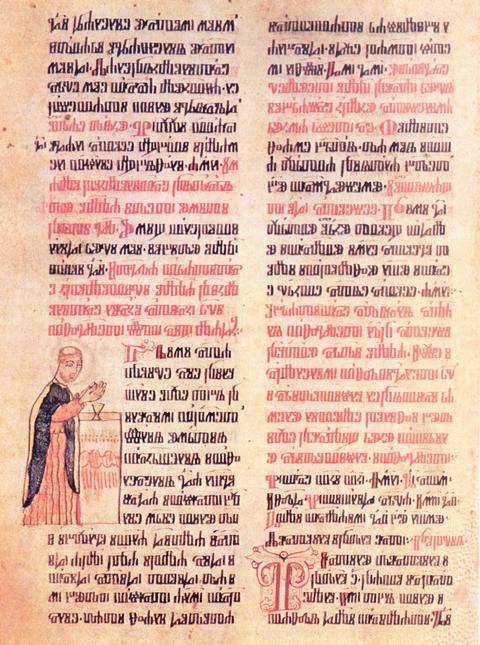
Illirico 8, Vatikanska apostolska knjižnica
Glagolitic books are kept also in Rome, in St.Peter's Archives. An important role for Croatia has Mavar's Breviary (Mavrov brevijar), written in Vrbnik on the island of Krk, 1460. It was written by a well known glagolitic priest and tipographer Blaž Baromić for a Vrbnik priest Mavar. In the period of 1471-1483 he was with his breviary in the region of Konavle south of Dubrovnik, about which he wrote a marginal note. At the end of the breviary he wrote "to pisa pop Mavar z'Vrbnika kada stojase v Konavli poli Dubrovnika" (i.e. Written by priest Mavar when he stayed in Konavle near Dubrovnik). The book has 417 vellum leaves with beautiful initials in red and green. It has a great number of ligatures, about 270. The book uses the Croatian name for the Glagolitic Script. The breviary was stolen from Vrbnik probably by the end of 18th century.
The book has been discovered in 1960s in Italy, and bought from a private proprietor in Rome in 1982, now kept in the National and Library in Zagreb. One of the Croatian breviaries is kept in Padova (1465) in the library of the Institute for Slavic Philology, and one from 14th century in Florence (Medici-Laurenziana biblioteca, sign. Plut. 1.10). The same institute in Padova has 18 Glagolitic documents. From the note written in the Tkon collection (1520) we know of a lost Glagolitic incunabulum (Ispovid opcena) printed in Bologna in 1492.
In the commune library in Siena there are two Glagolitic manuscripts, one of which was presented by Alberto Fortis. One copy of the Baromić breviary, a Croatian Glagolitic incunabulum from 1493, is kept in the Naples. The Archives of the Trieste Diocese possess the Croatian Glagolitic translation of the bull of Pope Gregory issued in Avignon in 1371 (see Vjekoslav Spincic's "Crtice iz hrvatske knjizevne kulture Istre", 1926, reprinted by KS, Zagreb 1984). Also the Municipal library in Trieste is in possession of Glagolitic books of the Brotherhood of Sv. Marija in Ugljan (i.e. Uljan, an island near Zadar) from 1617 to 1872 (see an article by Dr. Grozdane Franov Živković in Radovi zavoda za povijesne znanosti HAZU u Zadru, 62, Zagreb - Zadar 2020). On the other hand, the book of the Brotherhood of St. Antun from Zabezac, parish of Dolina near Trieste, written from 1548 to 1642 (in the Glagolitic until 1610), is kept in the State Archives in Zagreb. A fragment of Croatian Glagolitic breivary from the 15th century is kept in Biblioteca Civica "Attilio Hortis" in Trieste, as a binding of a book; see [Ferenčak, Iluminacije..., pp. 151-153].
The Biblioteca Seminario Teologico in Goriza, Italy, is in possession of the Croatian "Manoscritto glagolitico." In the church of San Francesco in Cividale there is a glagolitic graffito with the year 1402 written in glagolitic quickscript. Several glagolitic graffitos can be seen in Aquileia, near the cathedral, see here. It is known that an outstanding Italian scholar Arturo Cronia, Rome, had a bunch of Croatian Glagolitic manuscripts in his possession, but we do not know anything about their content and destiny after his death. Biblioteca Ambrosiana in Milano keeps Croatian glagolitic primer from 1527, Oficij rimski from 1530, published by Šimun Kožičić of Zadar in the Rijeka glagolitic priniting house, Brozić Breviary from 1561 and the Levaković Breviary from 1648.
In Italy, a number of new Croatian glagolitic graffitis have been discoverd dr. Brigitta Mader from Vienna (employed at the Austrian Academy of Science):
- Aquileia, "Si pisah ja pop Juraj Cvitović", graffito in the cathedral Chiesa dei Pagani (photo obtained by the courtesy of Alberto Črnec, Slovenia, in 2007)
- Assisi, glagolitic inscription in Basilica of St. Francis, 15th or 16 century, inscribed the second name of Kuždilić; in the convent of St Damian, 15. ili 16. ct., "Fra Šarafin Mihić Šibenčan 1650."
- Boršt near Kopar u Istria, glagolitic graffitto in the church of St. Roko
- Trieste, Contovello (Kontovel), Madonna della Slavia, glagolitic graffittis on the robe of a saint, 16th ct. ("ČFZI-1519 to pisa pop Ivan Berkinić", "1594. to pisa Ivan Berkina vnuk zgora pisanoga", and some other inscriptions: Amen, brije, rkovi, Juri Je, P(op) J, To pisa pop Mikula Tihomilić); Santa Maria Assunta - Madonna di Muggia Vechia, glagolitic graffitis from the 16 ct., PPT.
- Duino near Trieste in Italy, San Giovanni in Tuba (Štivan), glagolitic graffitto "ČFL-1550".
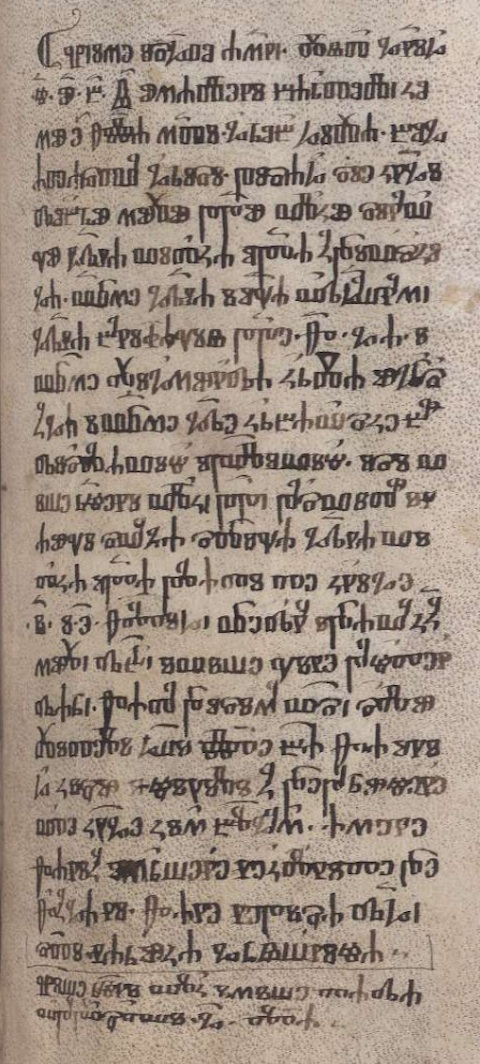
Colophone of the Berlin Missala from 1402. (The book was written by Bartol Krbavac):
V ime Isusovo Amen. Ljet Gospodnjih
1402. umaleni Bartol ko-
mu je zemlja mati, grob hiža, bog-
atstvo grisi, pisah sie knjigi
dobru mužu popu Vlku (Vuku), sinov-
cu gospodina Vitka, opata Koprivsko-
ga...
Kopriva - river Zrmanja; benediktine monastery of Kopriva was placed near the town of Obrovac.
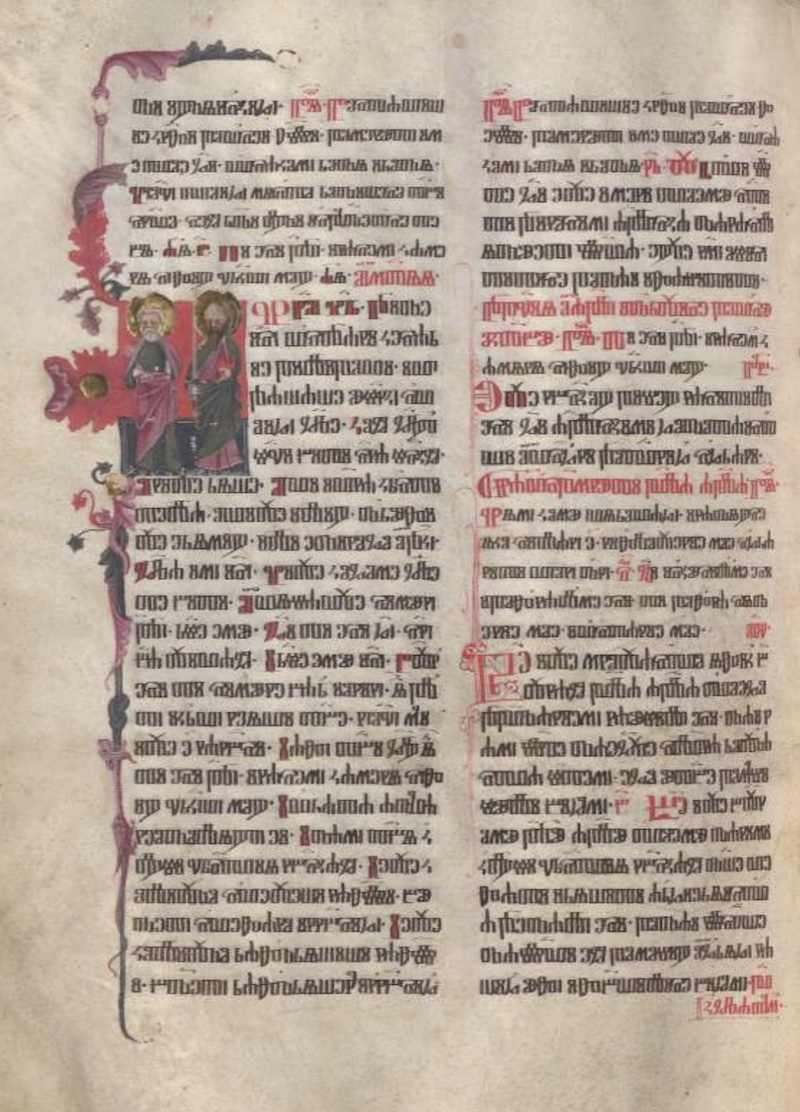
 If
you live in Berlin,
Germany, then you can see the beautiful Berlin
Missal (218 vellum leaves, i.e.
436 pages written by Bartol Krbavac
in 1402), kept in Staatsbibliothek (SBB-PK, Ms. Ham. 444). In 1624 a
Zadar archbishop sent it to Congregatio di Propaganda Fide in Rome in
order to prepare printed glagolitic books there. It is known that since
1808 the book was in Kensington House in London.
As a part of the so called Hamilton Collection (named according to a
Scottish collectioner Hamilton) it arrived from London to the Berlin
State Library in 1882, where it is also today.
If
you live in Berlin,
Germany, then you can see the beautiful Berlin
Missal (218 vellum leaves, i.e.
436 pages written by Bartol Krbavac
in 1402), kept in Staatsbibliothek (SBB-PK, Ms. Ham. 444). In 1624 a
Zadar archbishop sent it to Congregatio di Propaganda Fide in Rome in
order to prepare printed glagolitic books there. It is known that since
1808 the book was in Kensington House in London.
As a part of the so called Hamilton Collection (named according to a
Scottish collectioner Hamilton) it arrived from London to the Berlin
State Library in 1882, where it is also today.In Kassel, Germany, there is a fragment of Glagolitic missal (Kassel fragment) from 15th century. In Bamberg there is a Croatian glagolitic abecedarium from the first half of the 16th century (kept in Staatsbibliothek). A fragment of the Wertheim Glagolitic Missal from 14th century, consists of only one preserved parchment leaf (kept in the Fürstlich - Löwenstein - Wertheim - Gemeinschaftliches Archiv). There are several books published in the period of 1561-1564 by Croatian protestants, kept among others in Stuttgart, Magdeburg, Basel, Frankfurt am Main. In the city of Gotha in central part of Germany (in Forschungsbibliothek Gotha, under the catalogue number Memb. II 201), there is a fragment of benedictine Croatian Glagolitic missal from the 14th century (the so-called Gotha fragment), which consists of two parchement leaves.
In 1584, Slovenian grammarian Adam Bohorič published his most important book Arcticae horulae succisivae (Free Winter Hours) in Wittenberg in Germany in the Latin language, in which there is a table of Croatian Glagolitic Script. Its characters are called Croatian or Glagolitic letters, with a detailed presentation of this script:
Literae Croaticae seu
Glagoliticae.
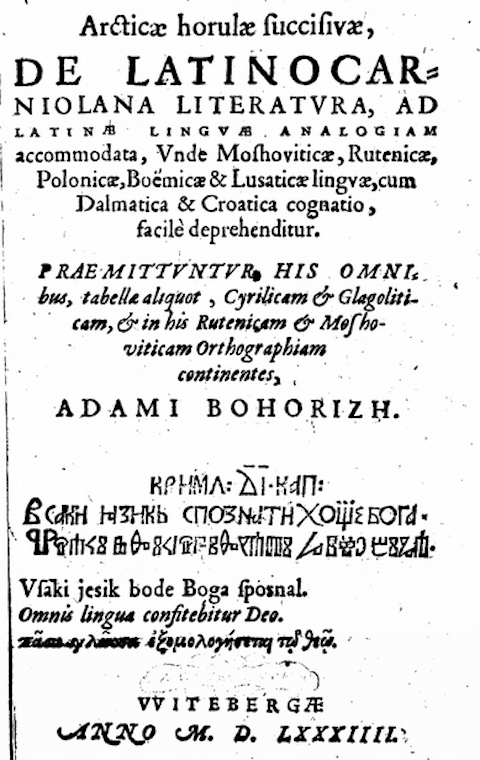
Adam Bohorič: Arcticae horulae succisivae (Free Winter Hours),
Wittenberg 1584; the title page of the book
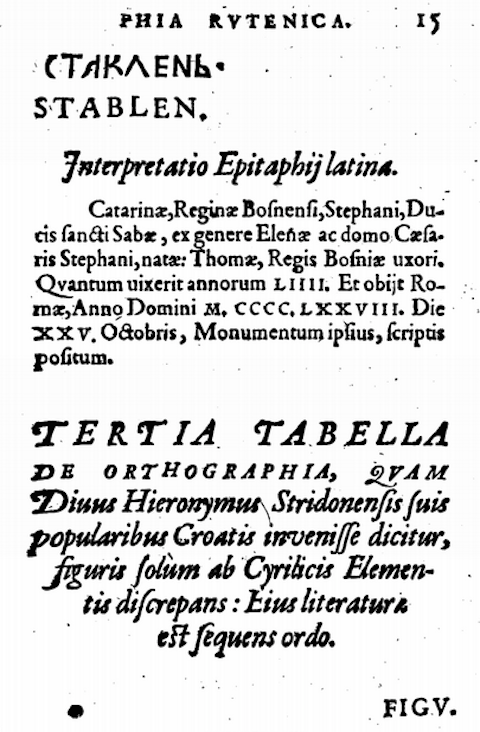
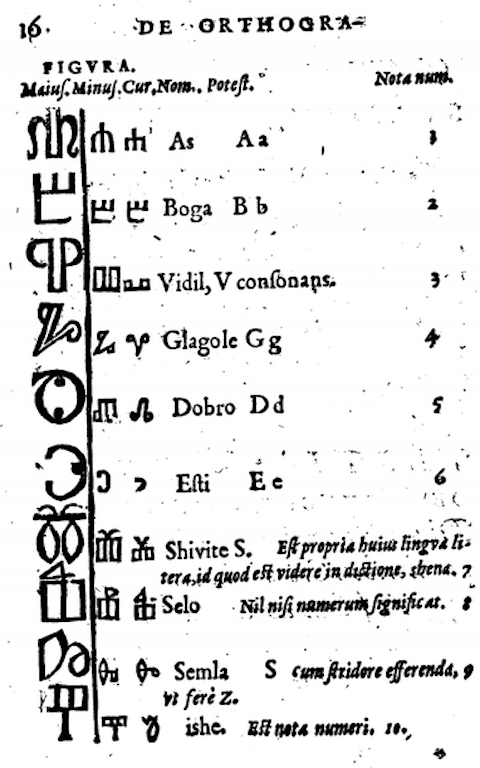
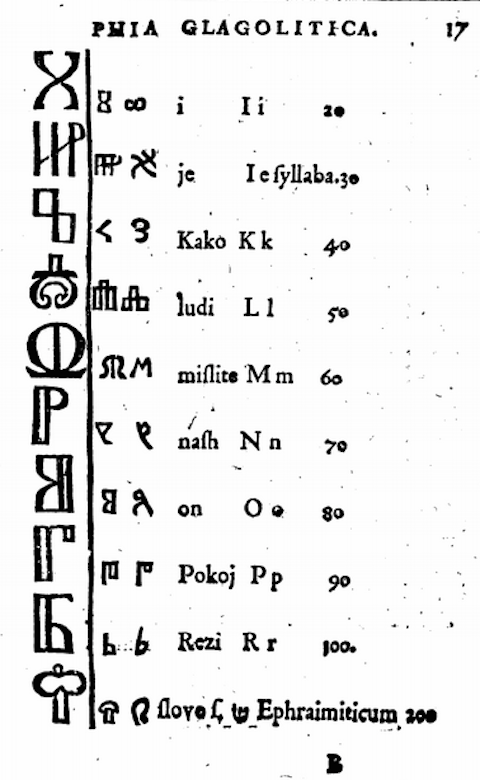
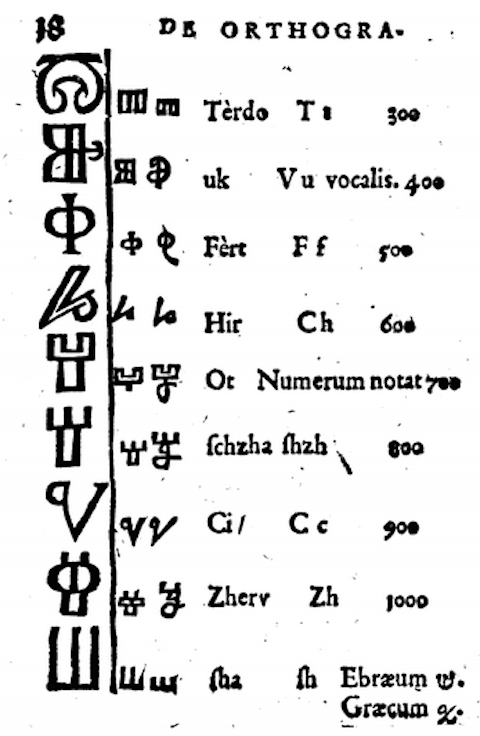
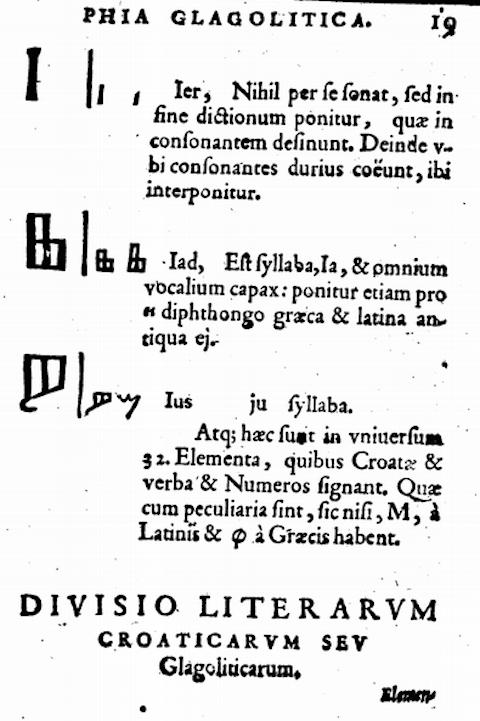
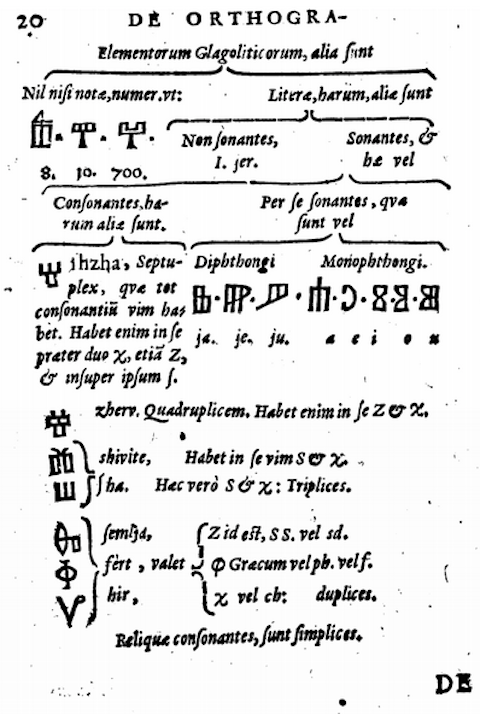
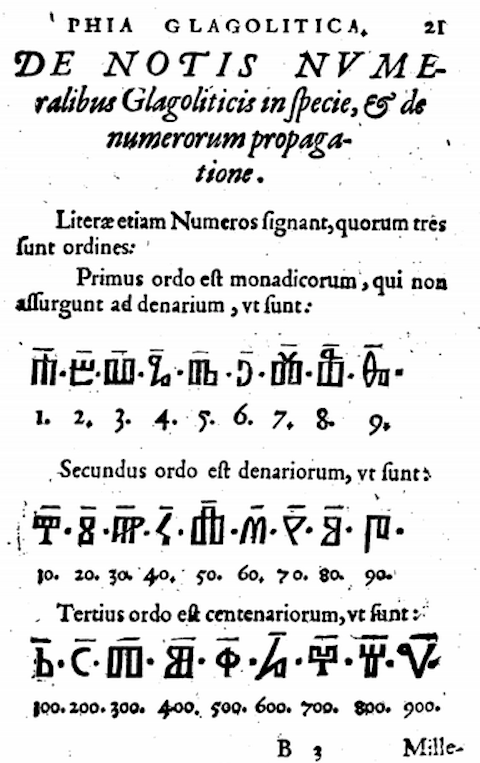
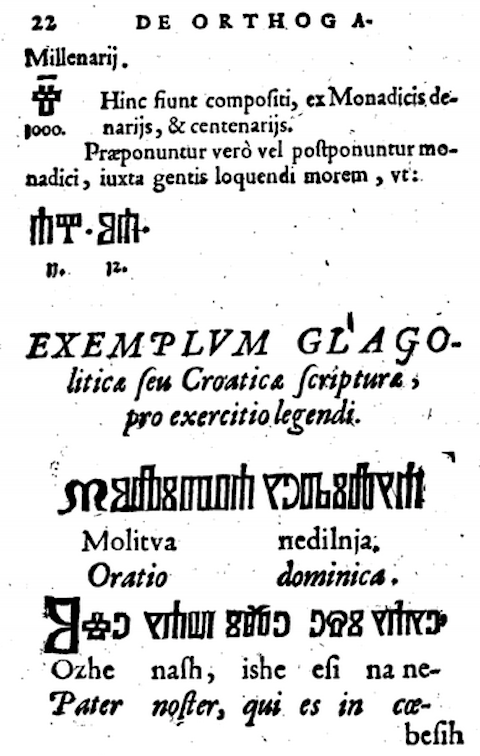
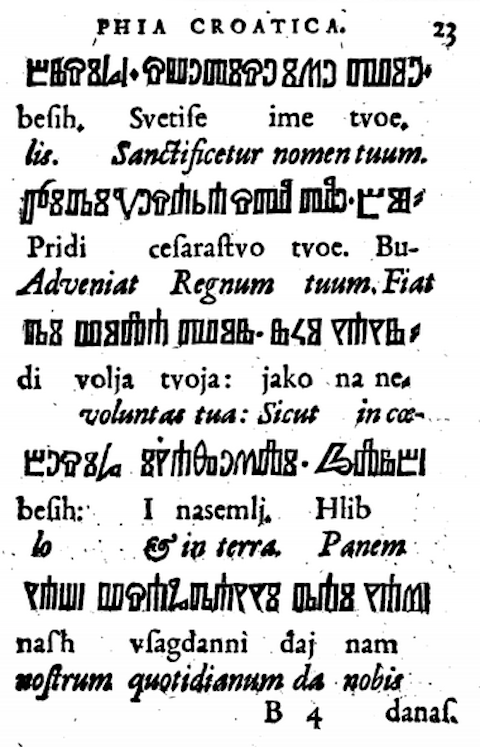
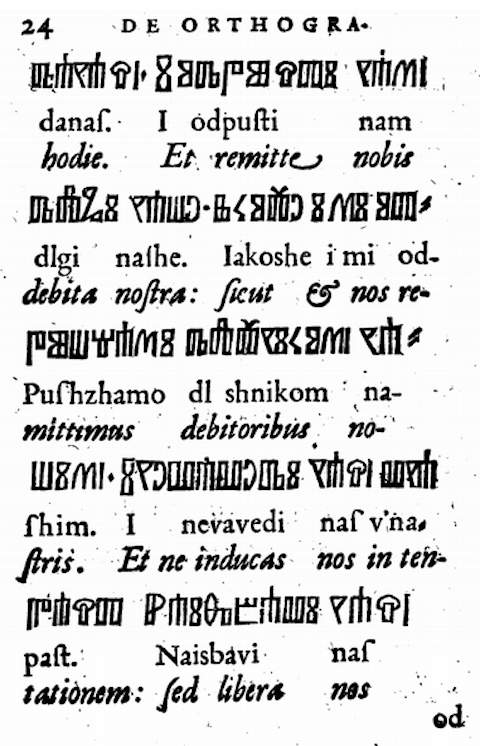
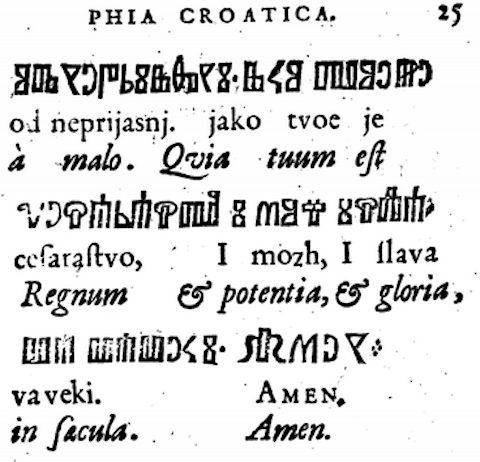
The glagolitic prayer book Oficij rimski (Officium Romanum), intended for private needs, was printed on December 15th, 1530. Seven copies are preserved: two of them kept in Zagreb, two in Sankt Peterburg (Russian Federation), and one copy in Milan, Rome (Italy) and in Weimar (Germany). Its reprint was prepared according to a very well preserved sample kept in the Collection of manuscripts and old books of the National and University Library in Zagreb, Croatia. Many thanks to Mirna Lipovac for this information.
In Switzerland, in the Basel University Library, there is a Croatian Glagolitic manuscript (fragment), N I 2 Nr. 148b, formerly in possession of Franz Miklosic. It is mentioned in M. Cuncic's article: "The Collection of Microfilms and Prints of the Staroslavenski Zavod at Zagreb", in: Polata knigopisnaja 9 (1984) 30-38, here p. 31. A detailed description can be found in the monograph by Roland Marti: "Beschreibung der slavischen Handschriften in der Schweiz", Bern etc. 1991, 25-27. Many thanks to Professor Marti (Universität des Saarlandes) for this information. Also, many thanks to prof. Gordana Kešina from Basel (working with Croatian pupils there), and to the University Library in Basel for the photo.
If you are a citizen of St. Petersburg in Russia, then you can see five complete codices and the important Bercic Collection, comprising 154 Croatian Glagolitic books and fragments (altogether 386 preserved folia), and 53 texts in Croatian Glagolitic quickscript, written between the 13th and 16th centuries, including five codices. The collection was a result of many years of painstaking efforts of Glagolitic priest and academician Ivan Bercic (Zadar, 1824-1870). Bought by the Russian Academy of Sciences in 1874, it is kept in the world famous Saltykov-Shchedrin Library (former Imperatorskaya publicnaya biblioteka, now Russian National Library). The Bercic collection represents the most important collection of Croatian Glagolitic heritage kept outside of Croatia, and contains remains of
- 55 Glagolitic missals,
- 77 breviaries and
- 7 literary collections.
- in Croatia (7),
- The Vatican Library (2),
- Vienna (National Library, 1)
- and in Washington (The Library of Congress, 1).
- 53 handwritten cursive glagolitic texts (legal documents, prayers) from 1460 till 18th century, originating mostly from Croatian coast,
- 10 documents texts in the the Croatian cyrillic (documents, prayers, letters), written between 1538 and 18th century,
- 10 texts in the
Latin script (letters, prayers, transliterations from the Glagolitic),
written between 1555 and 19th century.
Crotian glagolitic in Russia (in Croatian)
Russia
Sankt Peterburg
- Russian National Library: Berčiće collection
- Library of the Russian Academy of Sciences (I.I. Sreznjevski collection): 3 leaves of Croatian glagolitic breviary from 14/15th ct.; manuscript from 15th ct. - Collection of teaching of St. Jerome (73 pp.); Department of Manuscripts: Catholic church prayers - leaf of a Croatian glagolitic missal from the end of 15th ct.; 15 titles of printed Croatian glagolitic books in 19 copies
- Archive of the Russian Academy of Sciences (Fund of P.I. Prejs): 3 leaves of a Croatian glagolitic breviary from the 15th ct.
Moscow
- Russian State Library: Croatian glagolitic breviary from 1442-1443 in double binding; two leaves of a Croatian glagolitic breviary from 14/15th ct.; 15 titles of Croatian printed glagolitic books in 21 copies
- State Historical Museum (Gosudarstvenny Istoričeskij Muzej, GIM): 17 leaves of Croatian glagolitic missal from 15th ct.; three printed Croatian glagolitic books from 16th and 18th ct.; two Croatian glagolitic printed editions published in Tübingen (Menjšie Collection, the largest collection of rare and valuable books in GIM-a), as well as fragments of Croatian glagolitic parchment manuscripts of missals from the end of 14th or the beginning of 15tj ct.
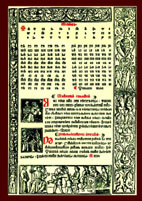 In
the Pierpont Library in New
York there is a 1527 copy of the
oldest known Croatian printed manual for children, printed in Venice in
the
Glagolitic script. The manual has 14 pages. Another complete copy is at
Harvard University Haughton Library in Cambridge MA, USA. Three
additional preserved copies are in Vienna (National Library), Oxford
(Bodleian Library) and St. Petersburg (State
Library).
There exists the sixth copy which appeared in 2006 at an auction in the
USA. It was sold for 35,000 USD (infromation by mr. Ivo Dubravcic,
Delft, the Netherlands).
Since 2007 this booklet is in possession of the National and University
Library, Zagreb, Croatia.
It is known that in 1933 this copy
was in Dresden,
Germany. Below you can see the colophon of the first Croatian primer
for children: Stampani v Bene / tcih po Andr / ei Torežani / iz Ažu /
le / 1527. Click on the photo to see the corresponding part in Italian.
Altogether 7 copies of the first Croatian printed manual for children
are known today.
In
the Pierpont Library in New
York there is a 1527 copy of the
oldest known Croatian printed manual for children, printed in Venice in
the
Glagolitic script. The manual has 14 pages. Another complete copy is at
Harvard University Haughton Library in Cambridge MA, USA. Three
additional preserved copies are in Vienna (National Library), Oxford
(Bodleian Library) and St. Petersburg (State
Library).
There exists the sixth copy which appeared in 2006 at an auction in the
USA. It was sold for 35,000 USD (infromation by mr. Ivo Dubravcic,
Delft, the Netherlands).
Since 2007 this booklet is in possession of the National and University
Library, Zagreb, Croatia.
It is known that in 1933 this copy
was in Dresden,
Germany. Below you can see the colophon of the first Croatian primer
for children: Stampani v Bene / tcih po Andr / ei Torežani / iz Ažu /
le / 1527. Click on the photo to see the corresponding part in Italian.
Altogether 7 copies of the first Croatian printed manual for children
are known today.
If you are a citizen of Moscow then you can see a fragment of handwritten Glagolitic breviary (1493) in the State Library (Gosudarstvennaya biblioteka), and an older Glagolitic breviary (250 folia), written in 1442-43 (bought in 1860 from the Turks by the Russian archeologist Sevastyanov for the Rumyancin library in Moscow). There are also Moscow fragments of a Croatian glagolitic missal from the 15th century have, written in a Paulist convent of St. Spas near Senj, and kept in the State Historical Museum in Moscow (Gosudarstvenny istoricheskij muzej, the collection of manuscripts of A.D. Chertkov, No. 387). A Russian scientist A.A. Kruming published a catalogue of printed Croatian Glagolitic books. A scholarly study about the Vinodol Code from 1288, has been published by Anna M. Evreinova in Sankt Peterburg in 1878, including the facsimle of the Code:
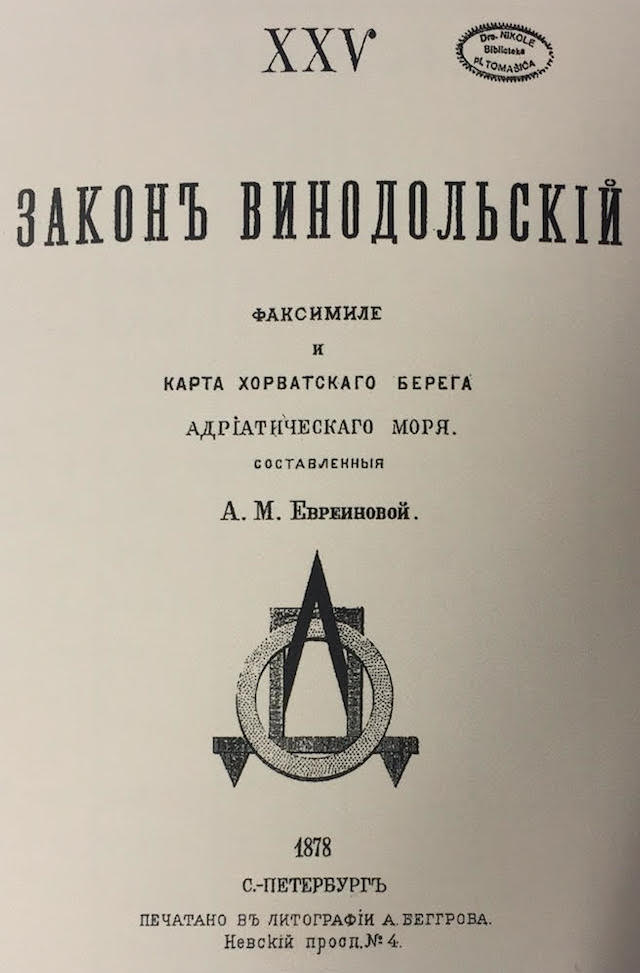
Vinodol Code
facsimile
and
a map of Croatian coast
of Adriatic sea.
Composed by
A. M. Everinova
1878
S.-Peterburg
Evreinova also published a study about the Krk Code (Krčkom zakon) from 1388.
In Odessa in Ukraine, there is a sample of the Missal of Pavao Modrusanin printed in 1528.
Ukraine
- Kiiv: Central Library of the National Academy of Sciences of Ukraine, keeps 7 Kiiv folia (the first of them is the youngest one, dating from the 12th century, written on the territory of Croatia, in the region of Dubrovnik, as proved in the scholarly study written by dr. Marija s. Agnezija Pantelić),
- Odessa, Odessa
State Scientifc Library, keeps a fragment of the missal of Pavao
Modrušanin printed in 1528.
In various libraries in Budapest, Hungary, there are about 10 valuable Croatian Glagolitic manuscripts from the early period - 12th to 15th centuries. Of particular importance is the 12th century ``Budapest Glagolitic fragment'' kept in the Hungarian National Library. In a University library there is also a number of Glagolitic fragments. In the Szeczenyi Library you can see the best preserved incunabulum of the Baromic Missal, printed in the Croatian town of Senj in 1494 (bought by Hungarians in Graz in the 19th century, for the huge sum corresponding to 150,000 DM, information by dr Antonija Zaradija Kis). Only 3 copies have been preserved, one of them is in the Saltykov-Shchedrin Library in St.Petersburg (Russia).
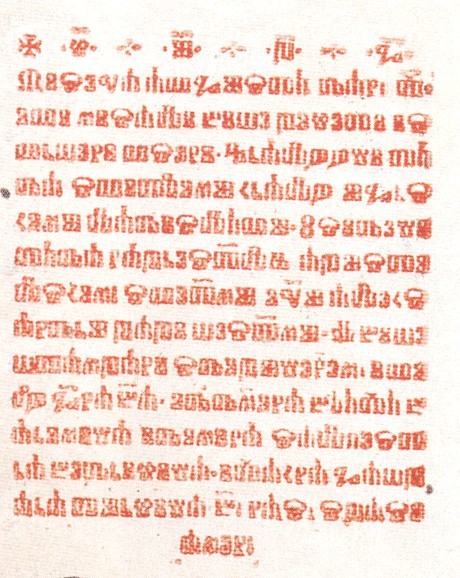
Colophon
of the Baromic missal, Croatian incunabulum from 1494 printed in Senj.
When the Paulist Order was cancelled in Croatia in 1782, all the
glagolitic archives were moved from Zagreb to Budapest.
In 1849/50, after the military action of ban Josip Jelačić in
Hungary, these Croatian books were returned to Zagreb. In 1885. an
infamous governer Khuen
Hedervary moved the whole collection again to Hungary. Finally, on the
basis of the 1947 Peace treaty with Hungary the archival collection was
again returned to Zagreb in the period of
1956-60. , see [Kolanović].
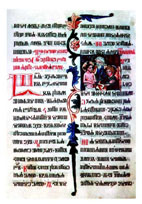 If
you live in Prague,
then you can see about 20 Croatian Glagolitic manuscripts from 14th to
15th centuries in the library of Narodni Muzeum. In "Narodni a
univerzitetni knihovna" (National and University library) you can see
the Kirin Croatian Glagolitic
psalter from 1359 (known also as
Lobkowitz Glagolitic psalter, according to one of its proprietors in
Czechia), written in the city of Senj by Kirin from Lika - Krbava
region. The Kirin psalter
is the oldest known Croatian Glagolitic psalm book. It is a complete
psalm book, and designed for singing. The National library also has a
monumental Czech Glagolitic
Bible from 1416 (38x29 cm),
where the copyists found it important to state that "the book was was
not written by Croat monks, but by Czech monks". The Bible written in
the Czech Church Slavonic language and in Croatian Glagolitic is an
interesting trace of Croatian culture in
Czechia.
If you visit an important Czech benedictine convent of Sazava
(now museum) built in 11th century, 60 km from Prague, then you will
have opportunity to see a room dedicated to the activities of Croatian
benedictines in Prague in 14th century. There we can read that the Évangelier de Reims
(also called Texte du Sacre,
or Livre de Coronation,
written by Croatian monks in Prague in 1395), was a book with
which for
centuries French
kings were sworn in. One
of them was Louis XIVth. More
about this book can be seen here.
If
you live in Prague,
then you can see about 20 Croatian Glagolitic manuscripts from 14th to
15th centuries in the library of Narodni Muzeum. In "Narodni a
univerzitetni knihovna" (National and University library) you can see
the Kirin Croatian Glagolitic
psalter from 1359 (known also as
Lobkowitz Glagolitic psalter, according to one of its proprietors in
Czechia), written in the city of Senj by Kirin from Lika - Krbava
region. The Kirin psalter
is the oldest known Croatian Glagolitic psalm book. It is a complete
psalm book, and designed for singing. The National library also has a
monumental Czech Glagolitic
Bible from 1416 (38x29 cm),
where the copyists found it important to state that "the book was was
not written by Croat monks, but by Czech monks". The Bible written in
the Czech Church Slavonic language and in Croatian Glagolitic is an
interesting trace of Croatian culture in
Czechia.
If you visit an important Czech benedictine convent of Sazava
(now museum) built in 11th century, 60 km from Prague, then you will
have opportunity to see a room dedicated to the activities of Croatian
benedictines in Prague in 14th century. There we can read that the Évangelier de Reims
(also called Texte du Sacre,
or Livre de Coronation,
written by Croatian monks in Prague in 1395), was a book with
which for
centuries French
kings were sworn in. One
of them was Louis XIVth. More
about this book can be seen here.
Croatian glagolitic in Czechia (in Croatian)
Colophone of the Kirin psalter from 1359.:
Se pisa Kir- | in žakan Bog mu pomagaj i sa vsimi ki budu | va nje
pjeti, amen. V ime Božje amen. Ljet gospodnji- | h 1359. kada te
knjigi biše pisani i d- | opisaše se v sv.
Kuzmi i Damjani v Senji.
Since 2012 there are two Croatian Glagolitic leaves in Cambridge, dating probably from the 15th century. They are in possession of Dr. Christopher de Hamel, Fellow of Corpus Christi College, University of Cambridge, Great Britain. They have been purchased at an auction in Munich in Germany. Here is one of the leaves (many thanks to Dr. de Hamel for having sent the photos and for permission to publish them):
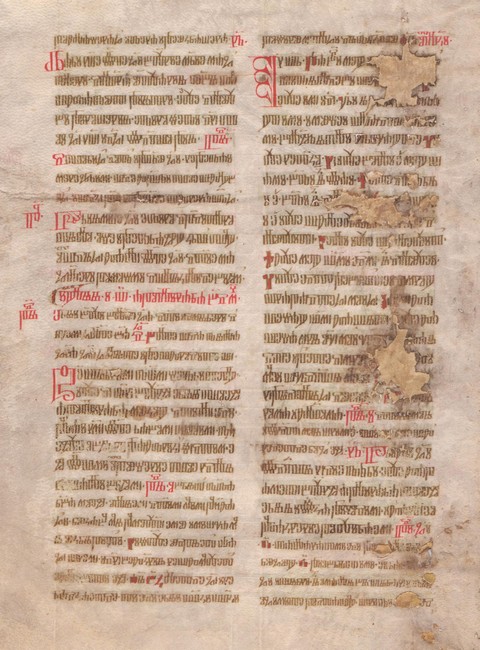
If you visit Martin in Slovakia, you can see two leaves from a Croatian glagolitic book from 14th century. They are called Hlaholske listi Hlohovske (kept in Matica Slovenska), that were previously in the town of Hlohovec. I owe this information to dr. Ralph Cleminson, University of Portsmouth, Great Britain. We know of a church vistator to Zahorska Bystrica in 1561 who noted that the habitation is Croatian (populus Croaticus), and that it has its own Glagolitic priest (see Glas Koncila, 3. October 2004, p. 13). According to Martin Slaninka, the Hlohovec leaves represent a fragment of a 13th/14th century Old Slavonic missal found in the Franciscan monastic library in Hlohovec in 1944. As the script exhibits rectangular character, the manuscript may be of Dalmatian provenance.
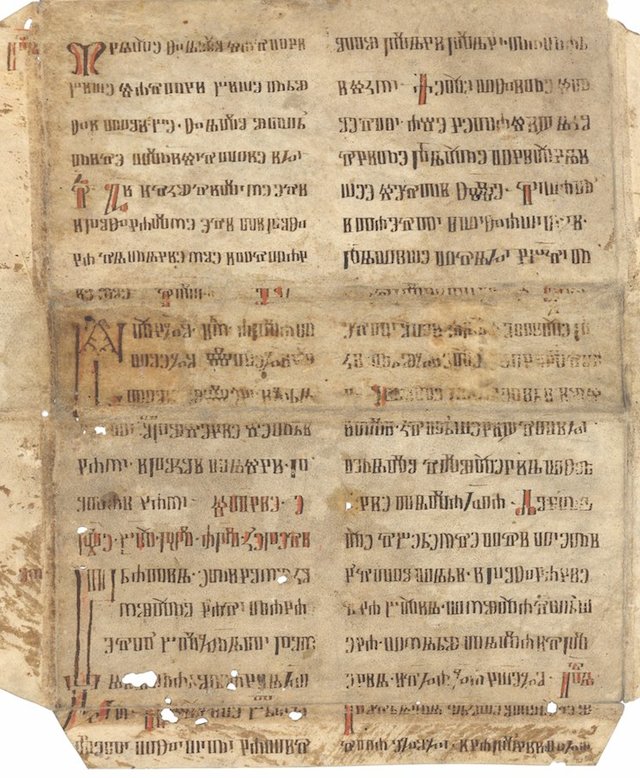
Hlaholske listy Hlohovske,
two Croatian Glagolitic parchment leaves from the
13/14th ct., kept in Slovakia.
More
information (many thanks to Martin Peterka and Peter Ivanič from
Slovakia for this link).
Croatian refugees who had to escape from Croatia to Slovakia in front of the Turks were in great majority čakavians (čakavci) from Croatian littoral (Primorje), wherefrom they brought the Glagolitic liturgy. A church visitator, who was in Záhorska Bytrica in 1562, populated by Croatians, wrote that the Mass is served in Croatian language (lingua croatica). The Mass was Glagolitic, since the report from that visitation the Croatian priest was mentioned as Plebanus Glagolita (Glagolitic priest). More about this can be seen in Dr. František Zagiba, Dejini slovenskej hudby, Bratislava 1944., pp 31 and 83. Záhorská Bystrica has no more Croatian population, due to assimilation. Since in the nearby village of Devinsko novo Selo the Croats still speak chakavian, as well as in the nearby village of Dubravka, we conclude that the Croats in Záhorska Bytrica were also chakavians (čakavci). See [Josip Andrić, pp. 166, 167].
Glagolitic leaves in Hlohovec (Hlaholske listi Hlohovske)The Krtiš glagolitic fragment
Saint-Antonian glagolitic fragment
For more information, see Peter Ivanič: Glagolitic texts in Slovak archives ([PDF]), Bašćina 17, Zagreb 2016, pp. 76-80.
Citizens of Paris can see several Croatian Glagolitic collections in Bibliothéque Nationale. Two exceptionally important Glagolitic codices are kept there: Code Slave 11 (14th century) containing the oldest known collection of Croatian religious lyrics, and Liber horarum (1317). Simun Kozicic Benja, the Krbava-Modrus bishop, founded his glagolitic printing house in the town of Rijeka in 1530. One of 6 published books was Knizice krsta, printed in 1531. Only three copies exist today: in Paris (Bibliothéque Nationale, sign. 49.052), in Sankt Petersburg (The State Library, sign. No 3093), and in Vicenza (Biblioteca Bertoliana) in Italy. The only copy of the earliest printed book in the Croatian Cyrillic (1512, prepared by Franjo Ratkovic from Dubrovnik) is also kept in Bibliothéque Nationale.
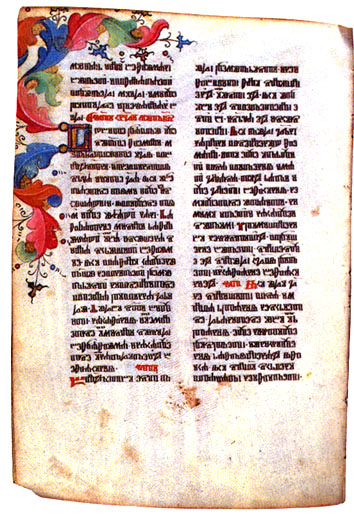
An important heritage of the Glagolitic writing written by George de Slavonie (14th century) is kept in the Bibliothéque Municipale of Tours in France.
In London you can also see a Croatian Breviary from the 15th century and the London fragment from the 13th century, a copy Missal of Pavao Modrusanin printed in 1528.
- Croatian Glagolitic heritage via the British library (in Croatian)
- Croatian
Collections in The British Library
We provide a photo of fragment of a Croation Glagolitic Breviary, written circa A.D. 1225. It is kept in London, in the British Museum Add. 31951, folio 1. (from A History of Writing, Albertine Gaur).
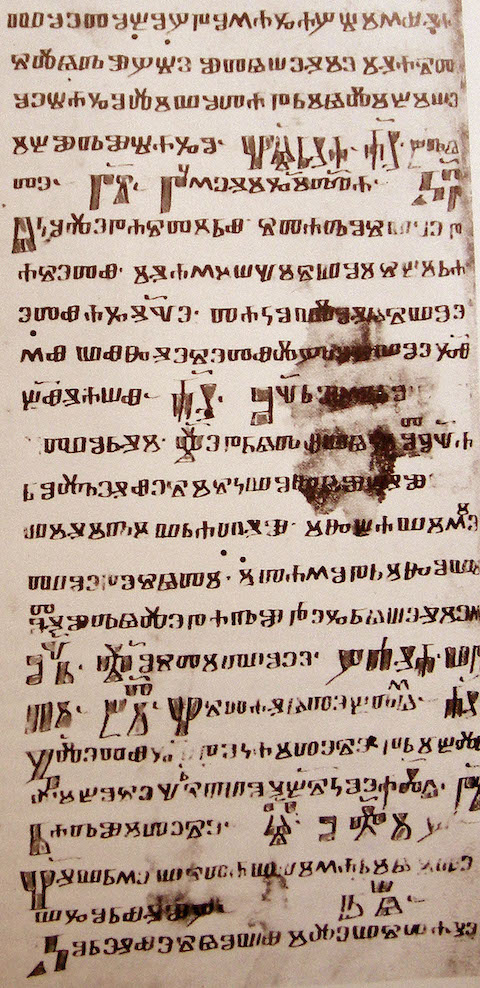
One may note the angular forms of the glyphs (typical Croatian) and the coloring of numerous letters, similar to various Latin codices. Croatia was/is normally under Latin sway. The above photo represents the right-hand column of the front page. The whole page can be seen here: [JPG]. Source of the photo and of the description is www.biblical-data.org.
A fragment of a monumental Croatian breviary dating from the 15th century, is kept in France. The present proprietor is David Nathan-Maister (a wine-maker in France), who bought a book in 2017 containing these fragments as its binding at an auction (Dreweatts & Bloomsbury Auctions) in London. The name of this Croatian-glagolitic fragment among scientists is LondAp (sic!), although at present it not kept in London any more, but somewhere in France. The book containing this Croatian Glagolitic binding seems to have arrived to Venice already in the 16th century. In the period of 17-18th centuries it was kept in Austria, while since the 20th century until 2016 it was in possession of Richard Doughty (proprietor of Cindarella Books in the USA). For more details, see [Žagar, Badurina Stipčević, Paskojević].
Very old and valuable Glagolitic manuscripts (at least six codices) and fragments can be seen in Oxford in the Bodleian Library. There is the Oxford breviary the early 15th century, two Oxford Glagolitic missals from 14th century, the Oxford collection from 15th century (among its proprietors was Alberto Fortis). It also possesses some Croatian Cyrillic manuscripts.
Here, we provide a short excerpt from the paper [Catherine Mary Macrobert] dealing with the Oxford breviary kept in the Bodleian Library:
The manuscript is supplied with a date at the end of the colophon on f. 409r: Dovaršenь lito .č.t.i., i.e. in 1310. However, the reliability of this information is highly questionable. The date itself has been added in a different hand from that of the colophon or indeed from those found elsewhere in the manuscript, and it is written, apparently over black lettering, in a dull red ink which again is different from that used for rubrication (D F 1971: plate). Tadin’s attempt to vindicate a date early in the 14th century (TADIN 1953: 153–155) was refuted by Hamm, who pointed out textual parallels with manuscripts of the 15th century (Hamm 1953: 118–119). More recent research has produced supplementary evidence in favour of a later dating (Badurina Stipčević 2006: 32; BADURINA STIPČEVIĆ 2009: 12; BADURINA STIPČEVIĆ 2010: 47–49), and this is further supported by the visual appearance of the manuscript: its ornamental initials have analogues from the early 15th century, e.g. at the beginning of the Pašmanski brevijar (Štefanić 1970: plate 27).
Although the manuscript is of modest size, it surely required a significant outlay on the part of the person who commissioned it: the parchment is of good quality, fine, white and polished; the lettering is even and competent, and the frequent deployment of ligatures suggests an experienced scribe; the ornamental initials, executed in red and blue, are elaborate, varied and delicate; there are figural inserts on f. 1r and f. 381v, and polychrome decorations with some use of gold on f. 286v, f. 271v, f. 272r and 278r (TADIN 1953: 152).
A citizen of Copenhagen can see a Glagolitic abecedarium and a Croatian Glagolitic Missal in Det Kongelige Bibliotek (Royal Library) from the end of the 14th century, called the Copenhagen Missal (Håndskriftet NKS 41 b). It is known that in 1499 the missal was in the town of Roč in Istria, Croatia. Until 1839 the book was in the Royal Library in Vienna, Austria, and this library later donated it as a gift to the Royal Library of Copenhagen.
The Copenhagen Missal, end of 14th century, the Royal Library Det Kongelige in Copenhagen, many thanks to dr. Mladen Ibler, Denmark, for the photo.
In Delft, The Netherlands, there is a well known printed Croatian glagolitic book Tranzit sv. Jeronima (Transit of St. Jerome, 1508., The Senj Glagolitic Printing House). The book belongs to private collection of Mr. Ivan Dubravčić. In his collection there are also some other Croatian glagolitic books:
- Nauk karstjanski kratak (1628);
- Azbukividnjak (1629);
- Bukvar (1753);
- Ispravnik (1635);
- Brevijar rimski (1648);
- Brevijar rimski (1791).
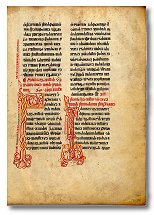 Any
citizen of Oslo,
Norway, can have a look on a beautiful vellum leaf from the island of
Krk, early 15th century, kept in the National Library, The Schoyen
Collection, MS 1391 . One of its proprietors was Jeremy Griffits,
Oxford. For more information see here.
The Schoyen collection has two glagolitic vellums that are a part of
the Rules of a Lay Fraternity on Krk. The rules mention the nobility of
Frankapans (prince Mikula and his princess Dorotea), islands of Rab,
Cres, and towns of Senj, Rijeka. The Schoyen collection possesses three
Croatian manuscripts in Latin and in Latin script from 11th, 12th and
13th centuries, probably from the famous Zadar scriptorium. My sincere
gratitude goes to Mr. Martin Schoyen, Norway, for his kind help. (In
2019, Martin Shchoyen sold these two Croatian Glagolitic vellum leaves
to an anonymous book-collector in the USA.)
Any
citizen of Oslo,
Norway, can have a look on a beautiful vellum leaf from the island of
Krk, early 15th century, kept in the National Library, The Schoyen
Collection, MS 1391 . One of its proprietors was Jeremy Griffits,
Oxford. For more information see here.
The Schoyen collection has two glagolitic vellums that are a part of
the Rules of a Lay Fraternity on Krk. The rules mention the nobility of
Frankapans (prince Mikula and his princess Dorotea), islands of Rab,
Cres, and towns of Senj, Rijeka. The Schoyen collection possesses three
Croatian manuscripts in Latin and in Latin script from 11th, 12th and
13th centuries, probably from the famous Zadar scriptorium. My sincere
gratitude goes to Mr. Martin Schoyen, Norway, for his kind help. (In
2019, Martin Shchoyen sold these two Croatian Glagolitic vellum leaves
to an anonymous book-collector in the USA.)
Croatian Glagolitic heritage in Norway (in Croatian)
By the end of Febrary 2020, we have learned that the two of the Batomalj leaves from 1425, that were kept in the National Library of Oslo (as a part of the famous collection of Martin Schoyen from Oslo), have been sold already on 10th July 2019 at an auction in London, for 12500 British pounds, to an unknown private collectioner in the USA. The selling was done by aucition company Christie's. If anybody learns the name of the present proprietor of these two Glagolitic leaves kept in the USA, we would appreciate informing us. Thank you.
The University Library of Uppsala, Sweden, is in possession three Croatian glagolitic books:
- the Brozic Breviary from 1561, printed in Venice (sign. Ksl 131), unique in the history of printing for its enormous amount of ligatures (250 of them!),
- Juan Polanco (?),
- Ispravnik za erei ispovidnici, printed in Rome in 1635.
One can clearly see that the table is written on a separate vellum leaflet, subsequently glued to the page of Gigas Librorum. The photo of the page of on which one can see the table of the Glagolitic Script can be seen on the internet page of the Royal Library in Stockholm. My gratitude goes to Mr. Nenad Hancic for information about the web adress. Undersigned on the glagolitic leaflet is Opat Divich, hardly readable. The same name can be seen on the neighbouring leaflet, glued on the same page to the right, containing the table of Croatian Cyrillic, signed lisibly with the name of the same Opat Divinic. Especially interesting is the last character in the first line: it is the Croatian Glagolitic djerv!
The year near the name is indicated as 1360-1366, showing that the origin of both leaflets is related to Croatian glagolites in Prague since 1348.
The public library in Porto (Portugal) has a Glagolitic book of Lenton readings dated 1460 (Biblioteca Publica Municipal, Ms 639-14-3-12).
The famous Escorial near Madrid (Spain) is in possession of a Glagolitic Missal, which is exhibited there (about 30x40 cm). The author of these lines would deeply appreciate any additional information, like the approximate time and place of its appearance. Also, a coffer (chest) with Croatian Glagolitic manuscripts (15th-16th century) is kept in Salamanca (personal information by academician Eduard Hercigonja, the chest with Croatian glagolitic manuscripts was seen in Salamanca by late academician Josip Hamm).
Marinka Šimić mentioned in her article [Šimić, Glagoljica na šibenskom području] that the Paris Miscellany from 1375 (Slave 73, also known as the Borislavić Miscellany) was in Spain during a certain period. Grgur Borislavić was born in Modruš (Modruška gorica). The miscellany was written in the city of Šibenik in 1375., which can be seen in the colophone to the book. Since 1951, the book is in Bibliothéque nationale in Paris.
A fragment containing three parchment leaves of the Croatian Glagolitic Missal from the 14th century is kept in the Jagiellon Library in Krakow. In the year of 1380 Konrad the II-nd, the prince of Olesnica (he belonged to Silesian line of Piast, the first Polish monarch family) founded a Glagolitic monastery in Olesnica town in Silesia province of Poland. Ten years later, in 1390, Jadwiga, the Polish queen and Wladyslaw Jagiello (Vladislaus Jagiello), her husband and, thanks of that, the Polish king (Jadwiga was polish queen before she married the Great Lithuanian Prince - Wladyslaw Jagiello), they founded a monastery (similar to that in Olesnica) under the invocation of The Saint Cross. It was established in Kleparz, the quarter of Krakow. Glagolitic liturgy existed there for about 100 years. That fact is described in: Jan Dlugosz (Ioannes Longinus; Ioannis Dlugosch) "Annales seu cronicae incliti Regni Poloniae" called also " Historia Polonica", or, as that in XVIIIth Century "Annales Poloniae Ioannis Dlugosch ad annum 1406" (one can find it in Czartoryski Library in Krakow, signature 1306). Queen Jadwiga was the daughter of the Polish king Ludwik Wegierski (Ludovig the Hungarian), the son of Elzbieta Lokietkowna (Elizabeth, the daughter of the Polish king Lokietek). Queen Jadwiga's mother was indeed the princess Elzbieta Bosniaczka, that is, Elizabeth of Bosnia. In Poland there is only a small piece of the Glagolitic missal, called Fragmenta Glagolitica, which is stored in the Krakow Jagiellonian Library, sign. 5567. Fire in 1584 damaged the monastery and all Glagolitic manuscripts.
My sincere gratitude goes to Professor Halina Watrobska, Slavonic Department of the University of Gdansk, Poland, who sent me the above information.
The crown of Quee Elizabeta Kotromanić is kept in the city of Zadar, Croatia,
inside the building of the monastery of benedictine nuns
(as a part of the permanent exhibition of the church art)
We know of the Krakov fragment, a remain of the Croatian glagolitic missal from the 12th century (see Eduard Hercigonja, his article in [Croatia and Europe, volume I, p 390]).
Several Glagolitic books issued by Croatian Protestants in the period of 1561-1564 are kept in the University Library in Wroclaw. There one can also find the best preserved sample of Simun Kozicic's Knjizice od zitija Rimskih arhijerejov i cesarov, printed in Rijeka in 1531.


Krakov fragment writtin in Croatian Glagoltic Script, stems from the half of the 14th century,
and is kept in the Library of the Jagiellonian University of Krakov, sign. 5567..
In Romania there are only five known samples of the Baromic Breviary, an incunabulum from 1493. Two of them are kept in Zagreb, in the National and University Library. The only complete copy in original binding is kept in Romania in Sibiu, in the library of the Brukenthal Museum. This very beautiful binding is composed of wood covered with leather, with imprinted metal ornaments. The other four samples are incomplete, and except the two kept in Zagreb, one is in Germany (Staatsbibliothek in Berlin) and another one in Austria (Schwarzau, Parma Library). See [Jaksic], and also Croatian glagolitic incunabulae. In the town of Sibiu in Romania there is also one of several preserved copies of the Missal of Pavao Modrusanin from 1528. g.
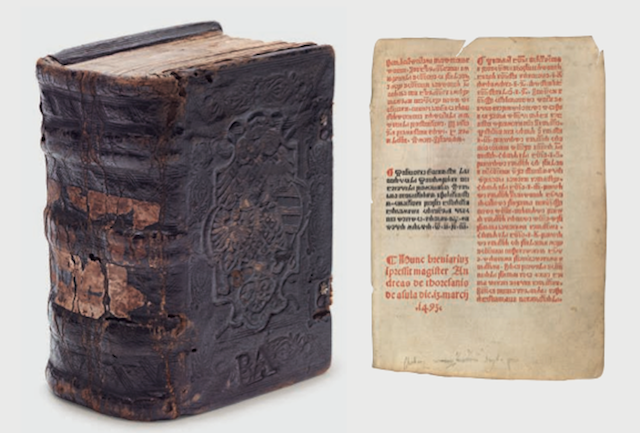
Baromić breviary from 1493 which appeared at an auction in London [PDF]
in 2015.
€ 57,000-85,000
Who is the proprietor of this Croatian incunabulum?
If you are a citizen of Bosnia-Herzegovina, then you can see some Glagolitic monuments Sarajevo, Fojnica, Humac and Banja Luka. An important stone Croatian Glagolitic monument from the 11/12th centuries, kept in the city museum in Banja Luka, has very probably been destroyed. A Glagolitic monument has been found near Jajce in 1996 (information by academician Stjepan Damjanovic).
Croatian Glagolitic sources related to Bosnia and Herzegovina (see also [Damjanovic, Glagoljica na podrucju danasnje BiH]):
- Kijevci fragment found near Kozara mountain found in NW Bosnia, 11/12th centuries, in its character very close to Glagolitic stone inscriptions in Western Slavonia (12/13th centuries) discovered in 1996,
- the Grskovic fragment of Apostle (12th century),
- the Mihanovic fragment of Apostle (12th century),
- inscription of prince Miroslav from Omis, 12th century (Croatian Cyrillic and Glagolitic),
- short Glagolitic inscription from Posusje (Grac), containing only two letters (T or V), according to Branko Fucic 12/13th centuries, see [Damjanovic, Glagoljica na tlu danasnje BiH]
- a leaf of Glagolitic parchment, known as the Split fragment of a missal (12/13th centuries), kept in the treasury of the Split Cathedral, probably from Bosnia (according to dr. Slavko Kovačić, its origin is from the environs of Split, probably from region of Poljica SE of Split),
-
Glagolitic inscription in Livno, (content: A SE PI / SA LU / KA DI / AK / 13 / 6 / 8) 1368, (and three more fragments, groblje sv. Ive)
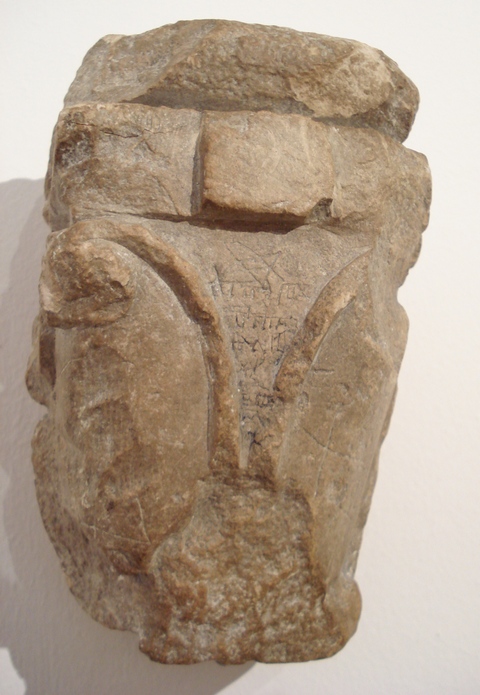
[1] [2] [3] [4]
Many thanks to dr. fra Bono Vrdoljak, Livno, for this information - In the Franciscan convent of Gorica in Livno two Croatian glagolitic fragments are kept: These are damaged parchment leaves of old Croatian breviaries. The Livno fragment contains biblical text from the Book of Job, that are very rare among preserved glagolitic manuscripts in Croatia - there are only four of them.
- Remains of
glagolitic script in Catholic cemeteries
near Tomislavgrad:
- Vojkovići
- Vučkovine kod Luga
- Sokolska isprava, cursive Glagolitic document from 1380, from western Bosnia (at that time part of Croatia, in Turkish time called Turkish Croatia),
- Kolunici inscription, 14/15th centuries, found near Bosanski Petrovac, with OSTOJA inscribed twice (the first one is mirror, in reverse order), see [Fucic]
- Inscription from Dragelja, south of Bosanska Gradiska, lost (there is no photo or drawing)
- Cajnice Evangelistary, 14/15th centuries, contains a part written in the Glagolitic script (St John, 17-20), and a Glagolitic alphabet (incomplete and rather deformed),
- Glagolitic inscription from Bihac (kept in Fojnica), is still studied,
- two glagolitic fragments on parchment from 14th century are today in the Franciscan Monastery Livno (Gorica)
- Glagolitic document from Ostrozac near Bihac in BiH, 1403, vellum with seal on purple silk ribbon, (kept in the archives of princes' of Auersperg in Ljubljana in 1890's, today probably in National Library of Ljubljana, [Lopasic, Bihać i bihaćka krajina, p. 294]),
- Hrvoje Glagolitic Missal, 1404 (kept in Constantinople, Library of Turkish sultans Topkapi Saray),
- Venice collection (Mletacki zbornik), written in the Cyrillic, was transcribed from glagolitic original (Josip Hamm)
-
Glagolitic inscription from Golubici near Bihac in western Bosnia (ie. Turkish Croatia), carved in 1440 and in 1442, mentioning knez Tomas (ie. Prince Toma Kurjakovic) from Krbava; it is kept in the famous Franciscan monastery in Fojnica in central Bosnia; this is the largest glagolitic inscription found on today's Bosnia and Herzegovina, see [Fucic, Glagoljski natpisi, p. 164];
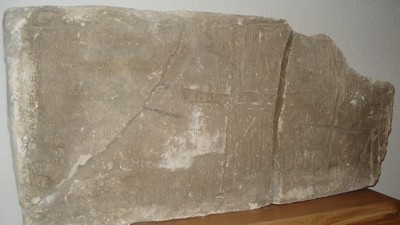
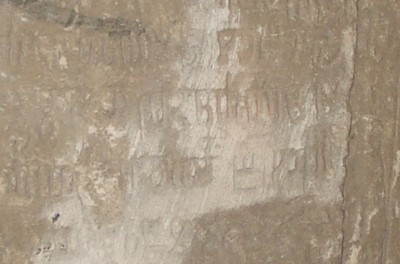
- Glagolitic page
from the
Manuscript of Krstyanin Radosav,
1443 - 1461 (kept in the Library of De Propaganda Fide in Rome),
transcribed into standard Croatian Glagolitic in 18th
century by Matija Sovic; the book contains also two Croatian Glagolitic
abecedariums, see one of them;
according to Josip Hamm the whole cyrillic book of Radosav was
transcribed from glagolitic original; Radosav wrote the Nikoljsko
evandjelje, which was also transcribed from glagolitic original;
- the
Manuscript of Krstyanin Hval,
1404 (copied from older Glagolitic
original; kept in University Library in Bologna since 18th century),
the manuscript contains glagolitic letters on two places
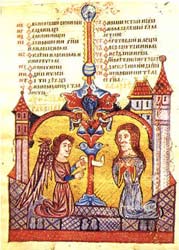


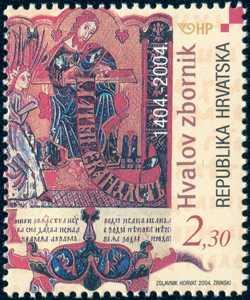
Hval's Manuscript, Croatian Post - the first and the second Glagolitic inscription from the vicinity of Banja Luka (Slatina) from 1471 (photos from [Poviest], see also [Fucic, Glagoljski natpisi -> Slatina]),
- Glagolitic muniments from Ostrožac, Ripač, Rmanja, Blagaj, Covac, Bihać, and Pec (mentioned by [Kreševljaković]),
- Glagolitic inscription on the left of the main entrance of Fethija mosque in the town of Bihac in western Bosnia, designating the year 1527 in glagolitic characters (Cc, Fi, I, Zz). The mosque used to be the dominican church before the arrival of Turks. See [Fucic, Glagoljski natpisi, p. 96].
- Some glagolitic books are kept in the Franciscan convent Gorica in Livno. [1] [2]
- Glagolitic
inscription with very cultivated letters, from Bužim near Bihać in
western Bosnia (ie. Turkish
Croatia), mentioning Prince Juraj
Mikuličić, who built the
fortress of Buzim against the Turks; mentions among others that "U
nu vrime va vsei hrvatskoj zemlji boljega covika ne bise..."
(ie. "At that time there was not a better man in the whole Croatian
land...", see the second line on the inscription below); it dates from
the end of the 15th century, and is kept in the Museum of the City of
Zagreb, see [Fucic,
Glagoljski natpisi, p. 112].

Glagolitic inscription from Bužim from the end of the 15. ct.
- Bihać, 1543, cursive glagolitic document (Archives of Croatian Academy of Sciences and Arts in Zagreb, Acta Croatica), see [Lopašić, Bihać i bihaćka krajina, p. 301].
- Bihać, 1573, message written in the Glagolitic script about Turkish preparations to attack the town; with seven seals, see [Lopašić, Bihać i bihaćka krajina, p. 305].
- See [Jolić, Duvanjski popovi glagoljasi, pp 297-301], and [Damjanović, Jezik hrvatskih glagoljaša]
- Turski glasi (Turkish voices; i.e., secret messages written in Croatian Glagolitic quickscript, reporting about Turkish troup movements in the then Ottoman Empire, near the Croatian border). In one of these documents, also the name of Dubrovnik appears written in the Glagolitic Script.
There is no doubt that the oldest phase of the Bosnian and Herzegovinean literature was Glagolitic. Numerous Cyrillic manuscripts were translated from older Glagolitic books. This can be seen for instance in the Mostar Evangelistary from the 14th century, written by Mihajlo Grk, kept in the Archive of the Serbian Academy in Belgrade. The last three glagolites in Bosnia died in 1834.
Here is an interesting monument from central Bosnia with inscription for which it is difficult to decide is it Croatian glagolitic, cyrillic, or something else:It is interesting
that in 1390, Jadwiga,
the Polish queen and her husband Wladyslaw
Jagiello (Vladislaus Jagiello),
founded a Glagolitic monastery under the invocation of The Saint Cross.
It was established in Kleparz,
the quarter of Krakow. Glagolitic liturgy existed there for about 100
years. Queen Jadwiga's mother was the princess Elzbieta
Bosniaczka, that is, Elizabeth of Bosnia.
Fra Matija Bošnjak is buried in the the church of sv. Franjo at the cemetary near the town of Rab, on Komrčar, on the island of Rab. (89 x 193 cm). The year of his death 1525. is chiseled in Croatian Glagolitic Script on the cushion. As a Bosnian refugee he escaped before the Turkish onslaughts to the city of Zadar, where he entered the order of Franciscan Glagolitic Tertiaries. He was among principal proponents of building new monasteries in Istria, Dalmatia and the Kvarner islands. He founded the convent of sv. Franjo in Rab where he died and is buried. According to Stjepan Ivančić, f. Matej Bošnjak (nicknamed de Jadera, i.e. from Zadar) is the father and founder of the Franciscan Order in Dalmatia. See [Fučić, Glagoljski natpisi, str. 296], [Ivančić, str. 38-42 and 238].
Kupres
village of Blagaj, parish of Rastičevo in Bosnia and
Herzegovina
Glagolitic inscription on the grave of don Jako Čota, 1807.
Don Jako Čota (rođen 1727. u Čačvinama kod Trilja, umro
1807. u Blagaju), hrvatski svećenik glagoljaš, pokopan je u BiH na
znamenitoj kupreškoj visoravni na "Čotinom groblju" u Blagaju, župa
Rastičevo. Lijepim glagoljičkim slovima upisan je sljedeći tekst
(polukružno iznad reljefa pokojnikova lika):
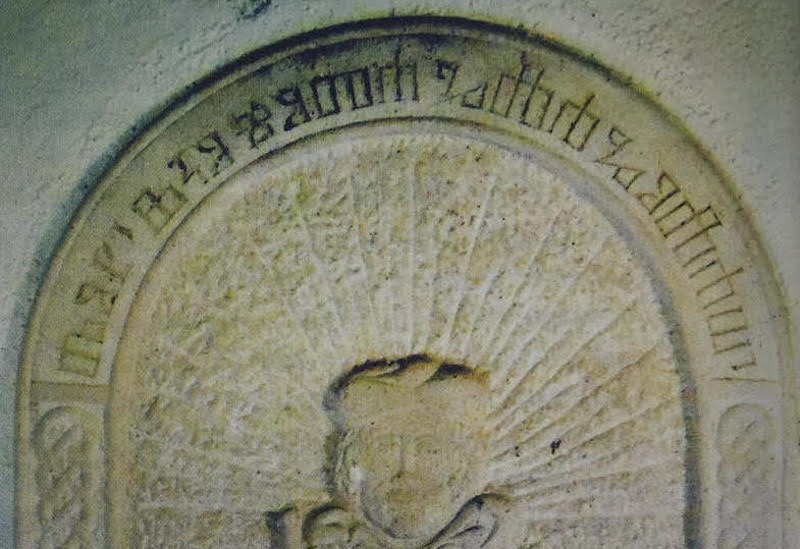
DON JAKO ČOTA, GLAGOLAŠ
Lit. Juraj Lokmer: Kupreški kraj, glagoljica s kupreške visoravni (2. dio), Bašćina br. 17 (2009.), str. 114-121.
Many thanks to Mr. Juraj Lokmer for permission to use his photo published in the above article.
Lit. Stjepan Damjanović: Glagoljica na području današnje Bosne i Hercegovine, Udruga đaka Franjevačke klasične gimnazije - Visoko, 2004.
In Yugoslavia, in Belgrade, there is a copy of Tabla za dicu (Glagolitic primer for children), issued in 1561 by Croatian protestants in Tübingen in Germany. This information is from 1938. We know that until 1982 the only known sample of Tranzita sv. Jerolima (1508) from the famous Senj Glagolitic Printing House was in Belgrade (as a part of the Nikola Pasic's library, it is not known how it arrived there).
In
Bulgaria, in Sofia,
in the Narodna biblioteka Kiril i Metodij, there is Postila, there is a
short
description of Sunday's Evangels during the year, printed in
Tübingen in 1562 in the Croatian Glagolitic. In the National Library of
St. Cyril and Methodius in Sofia a very interesting Croatian
glagolitic prayer book from 17/18th ct. is kept.
In the village of Bogdašić near the town of Tivat (Boka kotorska in Montenegro), in the church of Sv. Petar, a Croatian Glagolitic inscription has been found. Also the Glagolitic mass (i.e. Catholic mass served in Croatian Church Slavonic language instead of Latin language) has been in use in the church. The same for the village of Kostajnica near the town of Perast. These two parishes were glagolitic also in the 19th century. See [Pederin, p 247]. The use of Croatian Glagolitic Script is know to have taken place in the town of Škaljari south of Kotor. In 1469, in the church of sv. Trojstva (St. Trinity) in Škaljari there was a Kotor priest named Matej glagoljaš (Mathew the Glagolite). In 1745, in the Catholic church of Gospa Sniježna the inventory mentions a Croatian Glagolitic missal and evangel. A rare sample of Croatian Glagolitic missal from 1893 (Parčić missal) is known to have existed, from which a Škaljar Catholic priest don Marko Vučković was serving. Source. Very important role has a discovery of Croatian Glagolitic documents from 18th century in Gornja Lastva, a coastal village near the town of Tivat.
Ljubica Štambuk: Tragovi glagoljice u Boki kotorskoj (Traces of the Glagolitic Script in Boka kotorska)
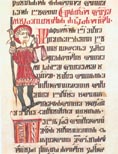 If
you live in Ljubljana
(Slovenia), then you can see some hundred Croatian Glagolitic
manuscripts and books, remains of breviaries and missals from 13th to
15th centuries, mostly in the National and University library. Other
remains of Croatian Glagolitic heritage are in Mojstrana, Hrastovlje, Kopar
(including its hinterland - Zanigrad, Predloka, Korte, Gazon, Puce,
Pomjan, Pridvor, Crni Kal), Novo Mesto, and elsewhere:
If
you live in Ljubljana
(Slovenia), then you can see some hundred Croatian Glagolitic
manuscripts and books, remains of breviaries and missals from 13th to
15th centuries, mostly in the National and University library. Other
remains of Croatian Glagolitic heritage are in Mojstrana, Hrastovlje, Kopar
(including its hinterland - Zanigrad, Predloka, Korte, Gazon, Puce,
Pomjan, Pridvor, Crni Kal), Novo Mesto, and elsewhere:
- The Beram Missal of Bartol Krbavac, around 1425,
- Prvi beramski brevijar, 15. st. (NUK)
- Drugi beramski brevijar, 15. st. (NUK)
- the Ljubljana homiliary (fragment of a breviary), National Library of Ljubljana, (13th century),
- Kamnje (near Nova Gorica), Kamenski glagolitic manuscript from 1583.
- Dornberk (Koparska biskupija), glagolitic inscription Juri pop 1574
- Glagolitic inscriptions around Kopar and Skofja Loka
- three vellum leaves from a Croatian Glagolitic breviary from 15th century kept in Novo Mesto
Two Croatian glagolitic books kept in the National Library of Ljubljana:
Fragment of a missal from Kosinj, bought in 1374 into Kosinj, written probably at the beginning of the 14th century in the area of Rijeka bay:
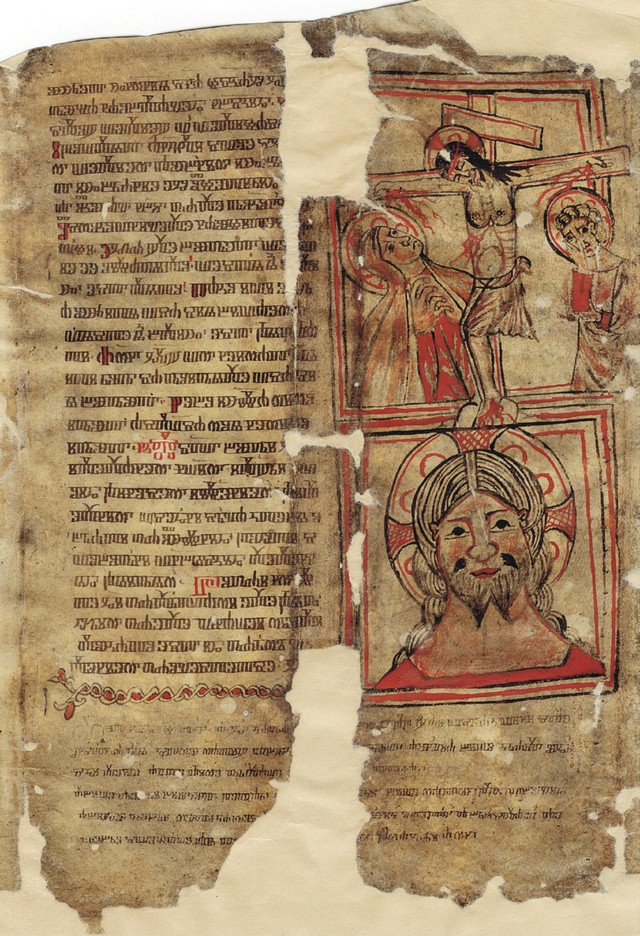
It
was in use in the Kosinj middle-age churches in the villages of Buci
and Srakovina. The church in Buci coincides with the present-day church
of St. Antun Padovanski i Gornji Kosinj (i.e., the Upper Kosinj), while
the village of Srakovina changed its name to Sraklin in the new era,
which was renamed to present-day Kosinjski Bakovac in 1913.See [Zor] and [Mance]. This is one of eight preserved leaves, kept in Podbrezje in the present-day Slovenia.
Gymnasium of the Diocese in Vipava, Slovenija, prepared a small exhibition of Croatian glagolitic:

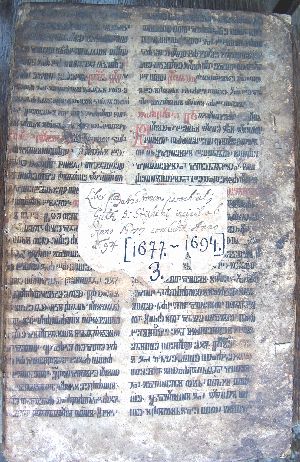
![Levakovic printed glagolitic missal from 1631 (Slovenians call it Krkavski misal [Krkavce]; one more copy is in the National Library in Ljubljana)](../gif/krkavsk.jpg)
For more information about Croatian glagolitic in Slovenia see several articles by Janez Zor:
- Glagolica na Slovenskem, Nahtigalov zbornik, Ljubljana 1977;
- Za fragmentite ot glagoličeski rokopisni misali v Slovenija, Palaeobulgarica/ Starobolgaristika (Sofija) 1984;
- Anonimna ali Metodova homilija v Clozovem glagolitu, Acta ecclesiastica Sloveniae 1985;
- Glagolski fragmenti v Arhivu Republike Slovenije, Rokopisi Arhiva Slovenije, Katalogi, zvezek 10, Ljubljana 1990;
- Slovar Brižinskih spomenikov (s sodelovanjem Franca Jakopina in Tineta Logarja), Znanstvenokritična izdaja, Monumenta Slovenica III, Ljubljana 1992;
- Trije glagolski fragmenti iz zapuščine barona Žige Zoisa, Ljubljana, 1997
- Glagolski fragmenti (24 pages; opis: Glagolica, prva slovanska pisava, je nastala v 9. st. in je že v času Žige Zoisa pritegovala pozornost članov njegovega razsvetljenskega kroga, še posebej Blaža Kumerdeja, Antona Tomaža Linharta in Jerneja Kopitarja. Zois je kot spodbujevalec njihovih jezikoslovnih raziskav kupil več starih rokopisov in tiskov, med njimi tudi tri fragmente, ki so najstarejša besedila v glagolici pri nas. To so fragment Ljubljanskega homiliarija (13. stol.), odlomka brevirja (14. stol.) in odlomka misala (15. stol). V faksimilirani obliki so ti dragoceni rokopisi izšli v počastitev 250-letnice rojstva barona Zoisa in seveda zato, da bi kot dragoceno študijsko gradivo postali dostopni tudi širši strokovni javnosti pri nas in v svetu. Izdaja natančno posnetih rokopisov - po izvirnih fragmentih, NUK, Ms 565/5 - je natisnjena v 100 oštevilčenih izvodih, vložena v zaščitno ovojnico in varovalno kartonsko mapo (25,5 x 34 cm). Spremljata jo izčrpna spremna študija Janeza Zora, izvrstnega poznavalca staroslovanskega in še posebej glagoljaškega kulturnega izročila in njegovih odmevov na naših tleh, ter razlaga razvojnih stopenj in posebnosti glagoskega črkopisa, ki jo je prispeval oblikovalec Lucijan Bratuš.)
- Glagolica (Slovenska enciklopedija)
- Zor, Janez: Fragmenti glagoljskega misala iz 1374 v Sloveniji?, 56-57 Slovo (2006-07), Zagreb 2008, pp. 653-693
In the article [Zor] it is possible to find data about fragments of a Croatian glagolitic missal from the 14th century written on the territory of Krbava (probably in 1374, or earlier), which is kept in the Archbishop's Archive in Ljubljana, in the People's and University Library (NUK) in Ljubljana, and in the towns of Križe pri Tržiču, Mengeš, Šmartno pri Litiji and in Vipava.
In the parish of Novo Mesto, a Croatian-Glagolitic leaf from the end of 13th or the beginning of 14th century is kept, containing the Passion of St. Marina. Information by dr. Vesna Badurina-Stipčević during her lecture delivered at the XIIth International Symposium Passion Heritage of Lika in Lički Osik near Gospić from 7th to 10th June 2018, organized by Pasionska baština association from Zagreb.
In Novom Mestu, in Kapiteljski arhiv, there is a part of Pazin fragments from the beginning of 14th century, discovered in 1985 by Janez Zor; [Mihaljević and Vince, pp. 7 and 8].
If you are a citizen of Zagreb, the capital of Croatia, then you can see the richest collection of Glagolitic books and manuscripts in the world, kept in the Archives of the Croatian Academy of Sciences and Arts. Also, a very rich and valuable collection is kept in the National and University Library in Zagreb. A smaller collection is kept in the Glagolitic Monastery of St Xaver in Zagreb and in the Municipal Library. In Zagreb there is also a professional institution - Staroslavenski zavod, whose main objective is to study very rich Croatian Glagolitic heritage. See also HERE.
For additional information about Croatian Glagolitic manuscripts outside of Croatia see [Nazor].
Croatian Glagolitic Missals and Breviaries
The author of these lines has collected the names of Croatian Glagolitic breviaries and missals (the approximate number, considerably smaller, was known already to Rudolf Strohal in 1915, but to my knowledge, the complete list of titles was never published on one place). The usual names of breviaries and missals are given. For some of them I do not know where they are kept. I would appreciate any additional information. Only about 30 breviaries and 20 missals are known that are completely preserved, while the rest are fragments. Here is the list of 16 (almost) completely preserved Croatian Church Slavonic Missale Plenums (see [Corin, p. 265]):
- Illirico 4,
(Vatican Apostolic Library), after 1317, the oldest known completely
preserved Croatian missal [according
to the article of Marin Tadin
from 1953, the oldest completely preserved Croatian Glagolitic
breviary-missal-ritual is kept in the Bodleian Library in Oxford, MS
Can Lit 172; see Eduard Hercigonja, Croatia-Europe,
volume II, and also Veronica M. du Feu [PDF],
D.Ž.]
- Illirico 8 (Vatican Library), 1441
- First Oxford Missal, Oxford, Bodleian Library, undated
- Second Oxford Missal, Oxford, Bodleian Library, undated
- Missal from Roch, Vienna, Austrian National Library, after 1420
- Missal of Prince Novak, Vienna, Austrian National Library, 1368
- Copenhagen Missal, Royal Library, Copenhagen, undated
- First Ljubljana Missal, Ljubljana, Nacionalna in univerzitetna knjiznica, undated
- Second Ljubljana Missal, Ljubljana, Nacionalna in univerzitetna knjiznica, after 1420
- Berlin Missal, Berlin, State Library, 1402
- First Missal from Vrbnik, Vrbnik, parish archives, 1456
- Second Missal from Vrbnik, Vrbnik Parish archives, 1462
- Missal from Novi, Novi, parish archives, undated
- Missal of Hrvoje Vukcic Hrvatinic, Istanbul, The Library of Turkish Sultans, Topkapi Sarayi, 1404
- New York Missal, The Pierpont Morgan Library, second quarter of 15th century
- Editio princeps (the first Croatian incunabulum), 1483
The list that follows is indeed impressive.
|
|
|
It is interesting that The Bercic Glagolitic collection in St. Petersburg only contains remains of as many as 55 missals and 77 breviaries from 13th to 16th centuries.
I believe that even this very fragmentary review illustrates more than enough spiritual and material power of Croatian glagolites in the period until 16th century, when the penetration of Turkish Ottoman Empire to Croatian lands resulted in their considerable impoverishment.
Croatian glagolitic heritage in
- world's libraries (in Croatian)
- Norway (in Croatian)
- USA (in Croatian)
- Russia (in Croatian)
- Czechia (in Croatian)
List of Glagolitic manuscripts at Wikipedia (incomplete, but valuable)
Hrvatske glagoljičke inkunabule
Croatian Glagolitic A:
 (1)
(1)
Croatian Glagolitic B:
 (2)
(2)
Croatian Glagolitic D:
 (5)
(5)
Croatian Glagolitic I:
 (20)
(20)
Croatian Glagolitic K:
 (40)
(40)
Croatian Glagolitic L:

 (50)
(50)
Croatian Glagolitic M:
 (60)
(60)
Croatian Glagolitic ligature ML:

Croatian Glagolitic N:
 (70)
(70)
Croatian Glagolitic O:
 (80)
(80)
Croatian Glagolitic R:
 (100)
(100)
Croatian Glagolitic S:
 (200)
(200)
Croatian Glagolitic T:
 (300)
(300)
Croatian Glagolitic V:
 (3)
(3)
Croatian Glagolitic Izhe:
 (10) I
adore it!
(10) I
adore it!
Mala enciklopedija hrvatske glagoljice
Back to Croatian Glagolitic

